Marketing Strategy for Huawei: Analysis, Competitive Advantage, and Recommendations
VerifiedAdded on 2023/01/16
|34
|5168
|52
AI Summary
This paper analyzes the marketing strategy of Huawei, including the external and internal analysis, competitive advantage, and recommendations for entering the global market. It also discusses the company's strengths, weaknesses, opportunities, and threats. The study recommends strategies based on Huawei's marketing mix.
Contribute Materials
Your contribution can guide someone’s learning journey. Share your
documents today.

Running head: MARKETING STRATEGY
Abstract
Huawei is the one of the global leading company in the telecom sectors along with the great
range of products that includes mobile phones, tablets, wearable, broad band devices and the
home devices. This is the manufacturer of the telecom equipment and the Chinese
multifunctional telecom company that is headquartered in Shenzhen, China. This first part will
be depend upon the external analysis and the internal analysis of the market. This will also
involve the external factors and the internal factors that creates risks for the business. In the first
part of the study, this will include the business competitive advantages and the present marketing
strategy of the business. In the second part of the paper the business will involve segmentation,
market and the business position in the market. This study also recommends the business
strategies of entering the global business market and these strategies are mostly based upon
Huawei’s marketing mix.
Abstract
Huawei is the one of the global leading company in the telecom sectors along with the great
range of products that includes mobile phones, tablets, wearable, broad band devices and the
home devices. This is the manufacturer of the telecom equipment and the Chinese
multifunctional telecom company that is headquartered in Shenzhen, China. This first part will
be depend upon the external analysis and the internal analysis of the market. This will also
involve the external factors and the internal factors that creates risks for the business. In the first
part of the study, this will include the business competitive advantages and the present marketing
strategy of the business. In the second part of the paper the business will involve segmentation,
market and the business position in the market. This study also recommends the business
strategies of entering the global business market and these strategies are mostly based upon
Huawei’s marketing mix.
Secure Best Marks with AI Grader
Need help grading? Try our AI Grader for instant feedback on your assignments.

1MARKETING STRATEGY
Table of Contents
Part 1...............................................................................................................................................4
1.0 Introduction..............................................................................................................................4
2.0 Situation analysis.....................................................................................................................4
2.1 Political condition................................................................................................................5
2.2 Economic condition.............................................................................................................6
2.3 Socio-Cultural condition.....................................................................................................7
2.4 Technological condition.......................................................................................................8
2.5 Environmental condition...................................................................................................10
2.6 Legal condition...................................................................................................................11
2.7 Strength..............................................................................................................................12
2.8 Weakness............................................................................................................................12
2.9 Opportunity........................................................................................................................12
2.10 Threats..............................................................................................................................13
3.0 Competitive advantage (USP)...............................................................................................13
4.0 Perceptual map......................................................................................................................13
5.0 Comparative analysis............................................................................................................14
5.1 Two competitor: apple and Lenovo.................................................................................14
5.2 Evaluation of current marketing strategy...........................................................................16
6.0 Survey.....................................................................................................................................18
Part 2.............................................................................................................................................24
1.1 Segmentation targeting and positioning (STP)...................................................................24
1.2 Time Space Chart of Target customers...............................................................................25
Table of Contents
Part 1...............................................................................................................................................4
1.0 Introduction..............................................................................................................................4
2.0 Situation analysis.....................................................................................................................4
2.1 Political condition................................................................................................................5
2.2 Economic condition.............................................................................................................6
2.3 Socio-Cultural condition.....................................................................................................7
2.4 Technological condition.......................................................................................................8
2.5 Environmental condition...................................................................................................10
2.6 Legal condition...................................................................................................................11
2.7 Strength..............................................................................................................................12
2.8 Weakness............................................................................................................................12
2.9 Opportunity........................................................................................................................12
2.10 Threats..............................................................................................................................13
3.0 Competitive advantage (USP)...............................................................................................13
4.0 Perceptual map......................................................................................................................13
5.0 Comparative analysis............................................................................................................14
5.1 Two competitor: apple and Lenovo.................................................................................14
5.2 Evaluation of current marketing strategy...........................................................................16
6.0 Survey.....................................................................................................................................18
Part 2.............................................................................................................................................24
1.1 Segmentation targeting and positioning (STP)...................................................................24
1.2 Time Space Chart of Target customers...............................................................................25

2MARKETING STRATEGY
2.3 Recommended objectives and goals (SMART)...................................................................27
Recommended marketing strategies based on the application of the marketing mix to your
chosen branded supermarket chain...........................................................................................28
1.3 Marketing Mix...................................................................................................................28
1.4 Conclusion..............................................................................................................................29
1.5 Bibliography...........................................................................................................................31
2.3 Recommended objectives and goals (SMART)...................................................................27
Recommended marketing strategies based on the application of the marketing mix to your
chosen branded supermarket chain...........................................................................................28
1.3 Marketing Mix...................................................................................................................28
1.4 Conclusion..............................................................................................................................29
1.5 Bibliography...........................................................................................................................31
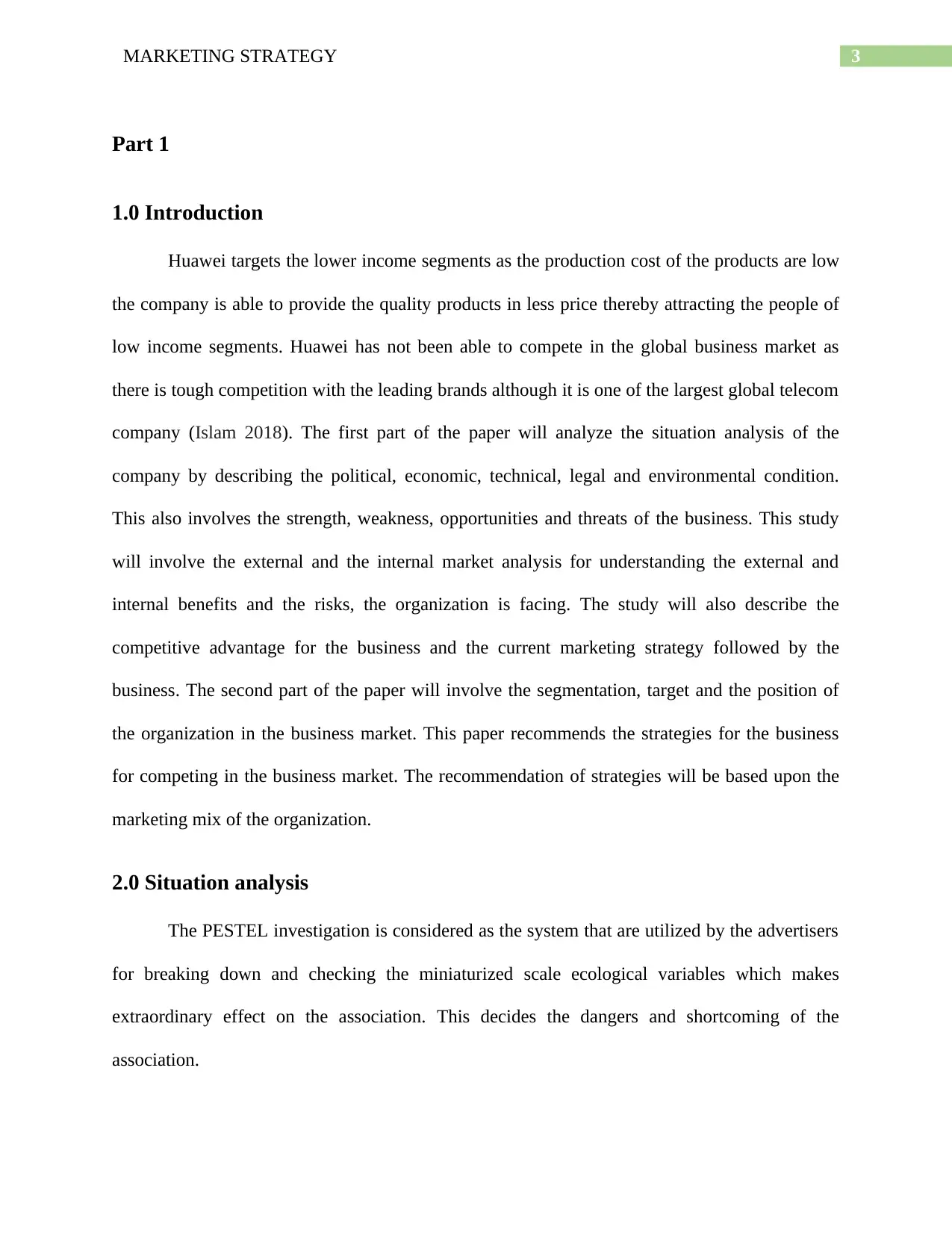
3MARKETING STRATEGY
Part 1
1.0 Introduction
Huawei targets the lower income segments as the production cost of the products are low
the company is able to provide the quality products in less price thereby attracting the people of
low income segments. Huawei has not been able to compete in the global business market as
there is tough competition with the leading brands although it is one of the largest global telecom
company (Islam 2018). The first part of the paper will analyze the situation analysis of the
company by describing the political, economic, technical, legal and environmental condition.
This also involves the strength, weakness, opportunities and threats of the business. This study
will involve the external and the internal market analysis for understanding the external and
internal benefits and the risks, the organization is facing. The study will also describe the
competitive advantage for the business and the current marketing strategy followed by the
business. The second part of the paper will involve the segmentation, target and the position of
the organization in the business market. This paper recommends the strategies for the business
for competing in the business market. The recommendation of strategies will be based upon the
marketing mix of the organization.
2.0 Situation analysis
The PESTEL investigation is considered as the system that are utilized by the advertisers
for breaking down and checking the miniaturized scale ecological variables which makes
extraordinary effect on the association. This decides the dangers and shortcoming of the
association.
Part 1
1.0 Introduction
Huawei targets the lower income segments as the production cost of the products are low
the company is able to provide the quality products in less price thereby attracting the people of
low income segments. Huawei has not been able to compete in the global business market as
there is tough competition with the leading brands although it is one of the largest global telecom
company (Islam 2018). The first part of the paper will analyze the situation analysis of the
company by describing the political, economic, technical, legal and environmental condition.
This also involves the strength, weakness, opportunities and threats of the business. This study
will involve the external and the internal market analysis for understanding the external and
internal benefits and the risks, the organization is facing. The study will also describe the
competitive advantage for the business and the current marketing strategy followed by the
business. The second part of the paper will involve the segmentation, target and the position of
the organization in the business market. This paper recommends the strategies for the business
for competing in the business market. The recommendation of strategies will be based upon the
marketing mix of the organization.
2.0 Situation analysis
The PESTEL investigation is considered as the system that are utilized by the advertisers
for breaking down and checking the miniaturized scale ecological variables which makes
extraordinary effect on the association. This decides the dangers and shortcoming of the
association.
Secure Best Marks with AI Grader
Need help grading? Try our AI Grader for instant feedback on your assignments.

4MARKETING STRATEGY
2.1 Political condition
The Chinese political environment plays a great role on the Huawei’s largest business
market. The governing party has a great influence on the economic environment of the country.
Thereby any incidence which effects the politics of China and has heavy impact on the profit
margin of Huawei. During the political promotions and the meetings of national Congress, the
stock prices of most of the Chinese business firm fall (Sanga 2017). The global profitability of
the business is subjected to the political climate of the respective country. On the other hand this
is found out that the international and the local politics could affect the business operations of
Huawei in the positive manner. The Chinese governments also supports the telecommunication
sectors by providing the sufficient training for the engineering students that increases the
effectiveness of the domestic labor force and this makes the domestic labor force highly
competitive. The loans and incentives for promoting the local manufacturers gives the local
business an edge for the foreign counterparts (Tarannum and Hassan 2016).
2.1 Political condition
The Chinese political environment plays a great role on the Huawei’s largest business
market. The governing party has a great influence on the economic environment of the country.
Thereby any incidence which effects the politics of China and has heavy impact on the profit
margin of Huawei. During the political promotions and the meetings of national Congress, the
stock prices of most of the Chinese business firm fall (Sanga 2017). The global profitability of
the business is subjected to the political climate of the respective country. On the other hand this
is found out that the international and the local politics could affect the business operations of
Huawei in the positive manner. The Chinese governments also supports the telecommunication
sectors by providing the sufficient training for the engineering students that increases the
effectiveness of the domestic labor force and this makes the domestic labor force highly
competitive. The loans and incentives for promoting the local manufacturers gives the local
business an edge for the foreign counterparts (Tarannum and Hassan 2016).

5MARKETING STRATEGY
Rank of China among 203 counties
Source (Market Research Blog, 2019)
2.2 Economic condition
The economic risks that the organization faces are that Apple becoming the major
competitors of Huawei have the vast resource reservoirs that Huawei struggles to increase the
capital, this affects the economic conditions of Huawei. Moreover the value added tax in the
telecommunication sectors increases the business operation cost and this also diminishes the
profitability margins of the business. But as the domestic economy is growing fast, this also
increases the disposable income and also the demand of the luxury products like the quality
mobile phones (Simões 2016).
Rank of China among 203 counties
Source (Market Research Blog, 2019)
2.2 Economic condition
The economic risks that the organization faces are that Apple becoming the major
competitors of Huawei have the vast resource reservoirs that Huawei struggles to increase the
capital, this affects the economic conditions of Huawei. Moreover the value added tax in the
telecommunication sectors increases the business operation cost and this also diminishes the
profitability margins of the business. But as the domestic economy is growing fast, this also
increases the disposable income and also the demand of the luxury products like the quality
mobile phones (Simões 2016).
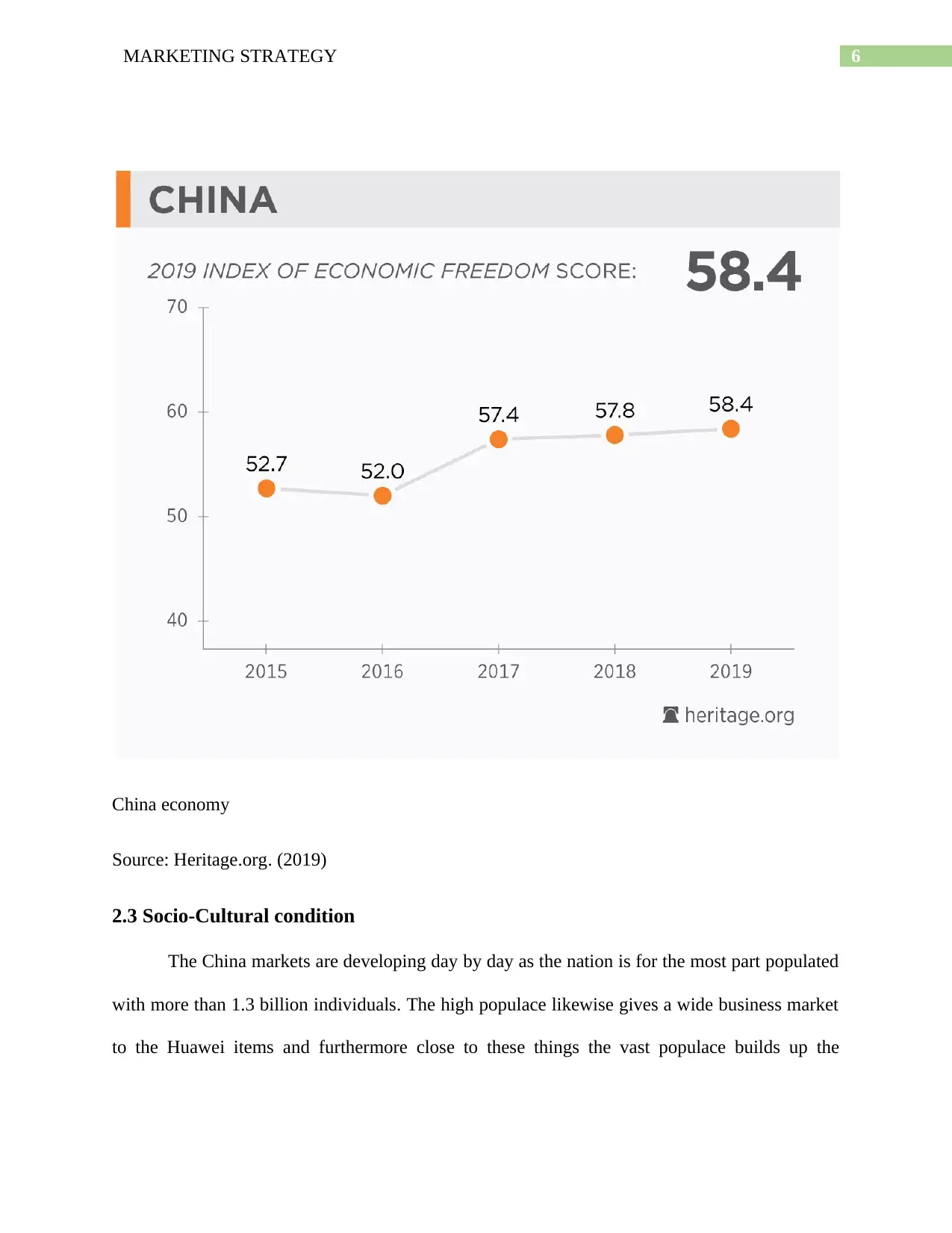
6MARKETING STRATEGY
China economy
Source: Heritage.org. (2019)
2.3 Socio-Cultural condition
The China markets are developing day by day as the nation is for the most part populated
with more than 1.3 billion individuals. The high populace likewise gives a wide business market
to the Huawei items and furthermore close to these things the vast populace builds up the
China economy
Source: Heritage.org. (2019)
2.3 Socio-Cultural condition
The China markets are developing day by day as the nation is for the most part populated
with more than 1.3 billion individuals. The high populace likewise gives a wide business market
to the Huawei items and furthermore close to these things the vast populace builds up the
Paraphrase This Document
Need a fresh take? Get an instant paraphrase of this document with our AI Paraphraser
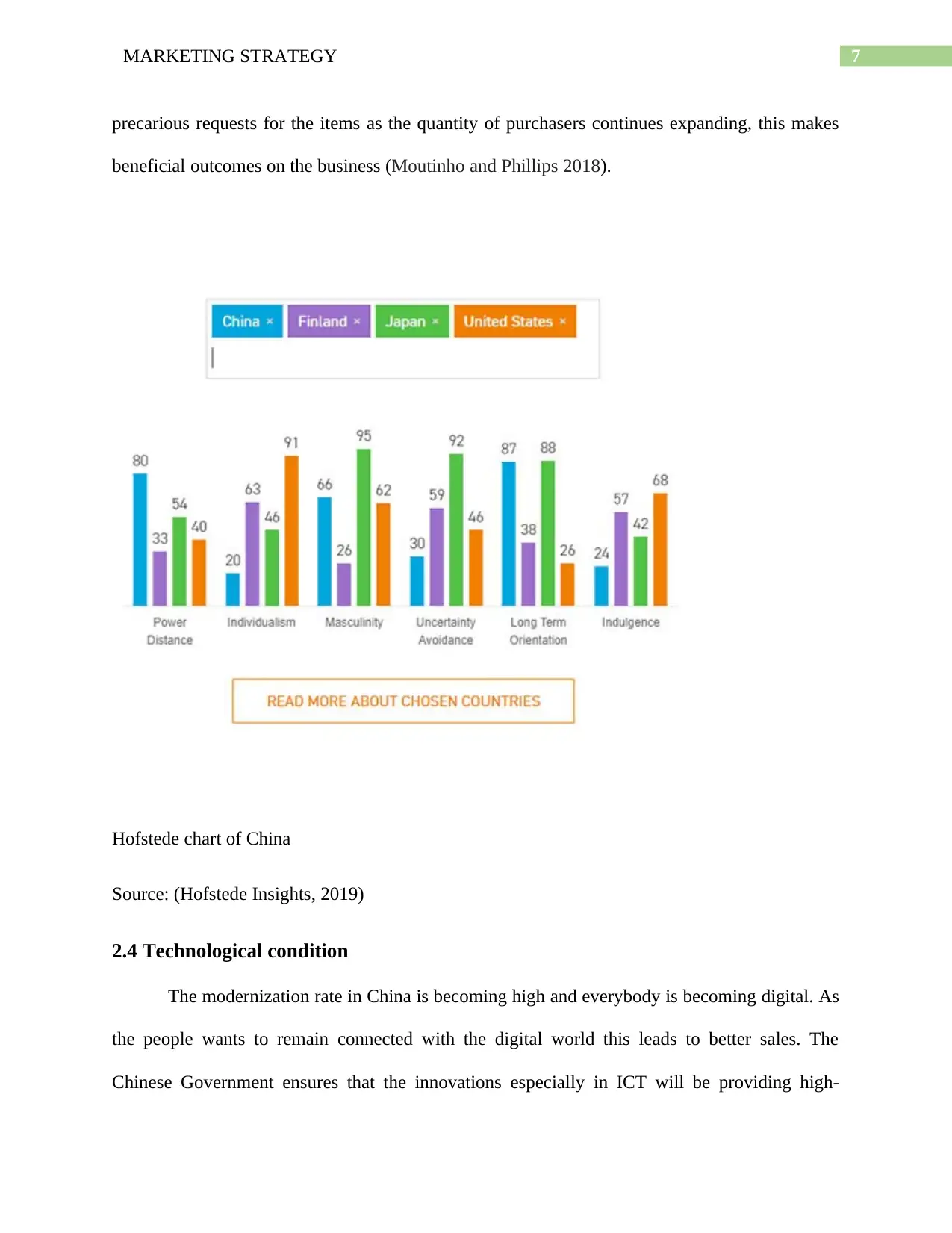
7MARKETING STRATEGY
precarious requests for the items as the quantity of purchasers continues expanding, this makes
beneficial outcomes on the business (Moutinho and Phillips 2018).
Hofstede chart of China
Source: (Hofstede Insights, 2019)
2.4 Technological condition
The modernization rate in China is becoming high and everybody is becoming digital. As
the people wants to remain connected with the digital world this leads to better sales. The
Chinese Government ensures that the innovations especially in ICT will be providing high-
precarious requests for the items as the quantity of purchasers continues expanding, this makes
beneficial outcomes on the business (Moutinho and Phillips 2018).
Hofstede chart of China
Source: (Hofstede Insights, 2019)
2.4 Technological condition
The modernization rate in China is becoming high and everybody is becoming digital. As
the people wants to remain connected with the digital world this leads to better sales. The
Chinese Government ensures that the innovations especially in ICT will be providing high-
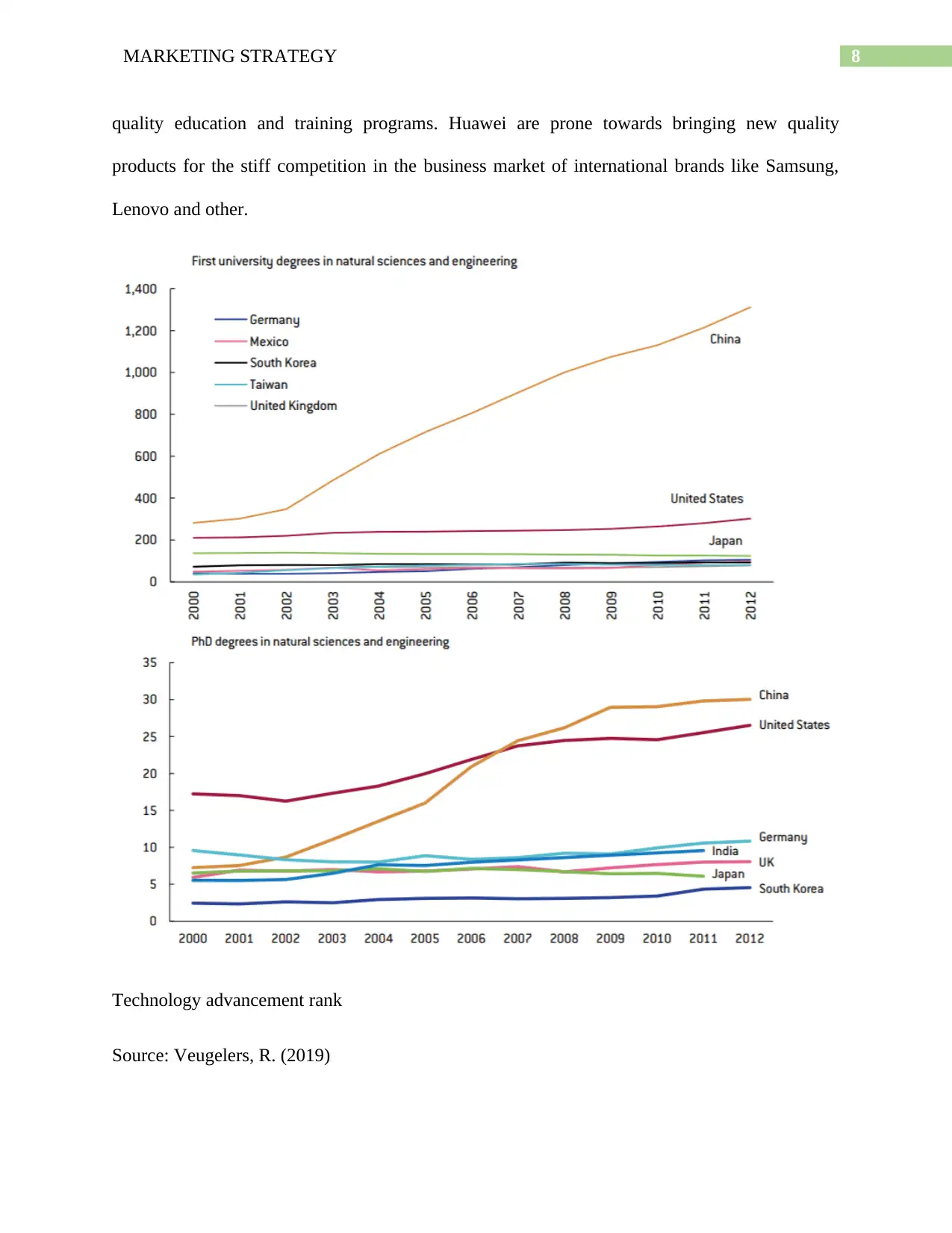
8MARKETING STRATEGY
quality education and training programs. Huawei are prone towards bringing new quality
products for the stiff competition in the business market of international brands like Samsung,
Lenovo and other.
Technology advancement rank
Source: Veugelers, R. (2019)
quality education and training programs. Huawei are prone towards bringing new quality
products for the stiff competition in the business market of international brands like Samsung,
Lenovo and other.
Technology advancement rank
Source: Veugelers, R. (2019)
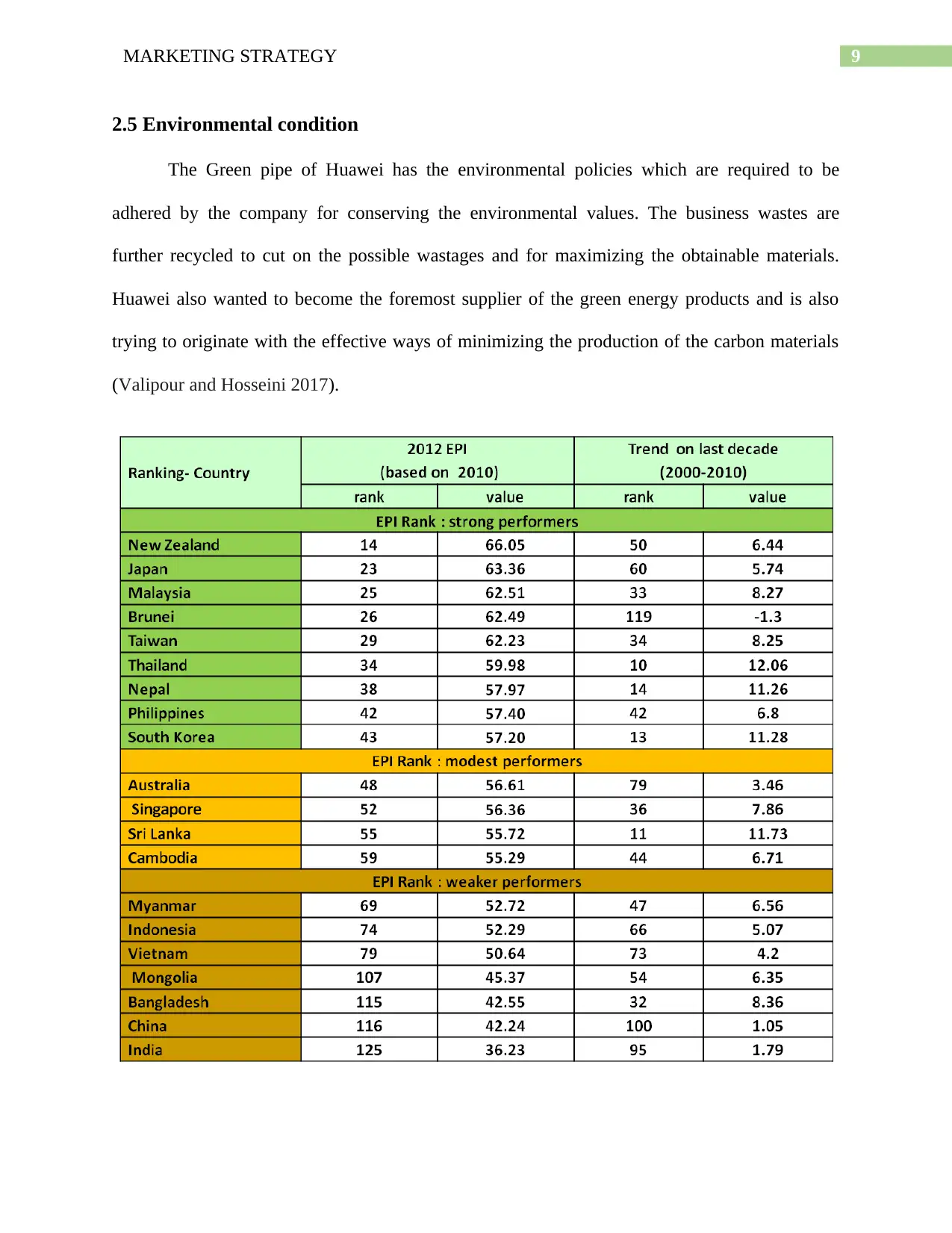
9MARKETING STRATEGY
2.5 Environmental condition
The Green pipe of Huawei has the environmental policies which are required to be
adhered by the company for conserving the environmental values. The business wastes are
further recycled to cut on the possible wastages and for maximizing the obtainable materials.
Huawei also wanted to become the foremost supplier of the green energy products and is also
trying to originate with the effective ways of minimizing the production of the carbon materials
(Valipour and Hosseini 2017).
2.5 Environmental condition
The Green pipe of Huawei has the environmental policies which are required to be
adhered by the company for conserving the environmental values. The business wastes are
further recycled to cut on the possible wastages and for maximizing the obtainable materials.
Huawei also wanted to become the foremost supplier of the green energy products and is also
trying to originate with the effective ways of minimizing the production of the carbon materials
(Valipour and Hosseini 2017).
Secure Best Marks with AI Grader
Need help grading? Try our AI Grader for instant feedback on your assignments.
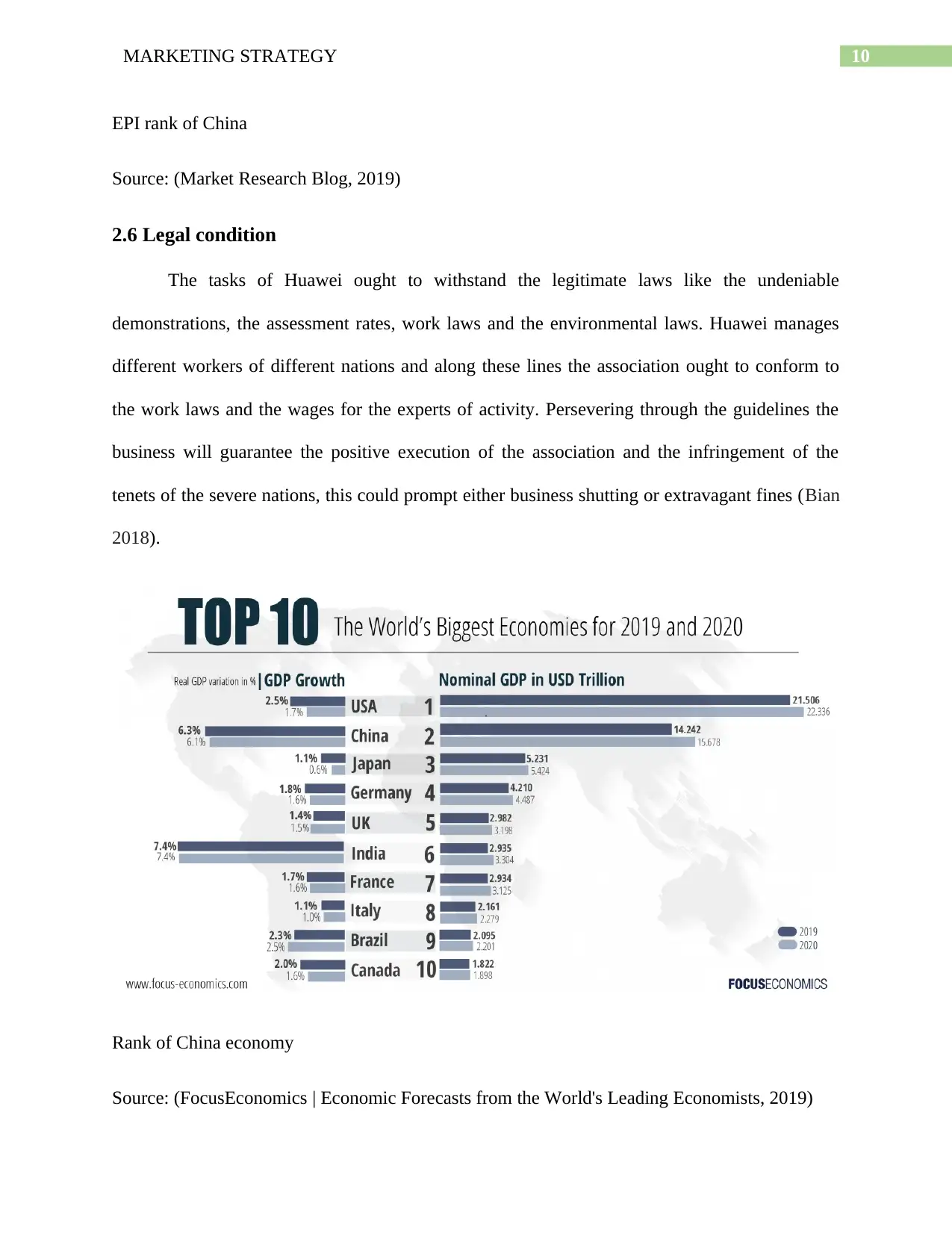
10MARKETING STRATEGY
EPI rank of China
Source: (Market Research Blog, 2019)
2.6 Legal condition
The tasks of Huawei ought to withstand the legitimate laws like the undeniable
demonstrations, the assessment rates, work laws and the environmental laws. Huawei manages
different workers of different nations and along these lines the association ought to conform to
the work laws and the wages for the experts of activity. Persevering through the guidelines the
business will guarantee the positive execution of the association and the infringement of the
tenets of the severe nations, this could prompt either business shutting or extravagant fines (Bian
2018).
Rank of China economy
Source: (FocusEconomics | Economic Forecasts from the World's Leading Economists, 2019)
EPI rank of China
Source: (Market Research Blog, 2019)
2.6 Legal condition
The tasks of Huawei ought to withstand the legitimate laws like the undeniable
demonstrations, the assessment rates, work laws and the environmental laws. Huawei manages
different workers of different nations and along these lines the association ought to conform to
the work laws and the wages for the experts of activity. Persevering through the guidelines the
business will guarantee the positive execution of the association and the infringement of the
tenets of the severe nations, this could prompt either business shutting or extravagant fines (Bian
2018).
Rank of China economy
Source: (FocusEconomics | Economic Forecasts from the World's Leading Economists, 2019)
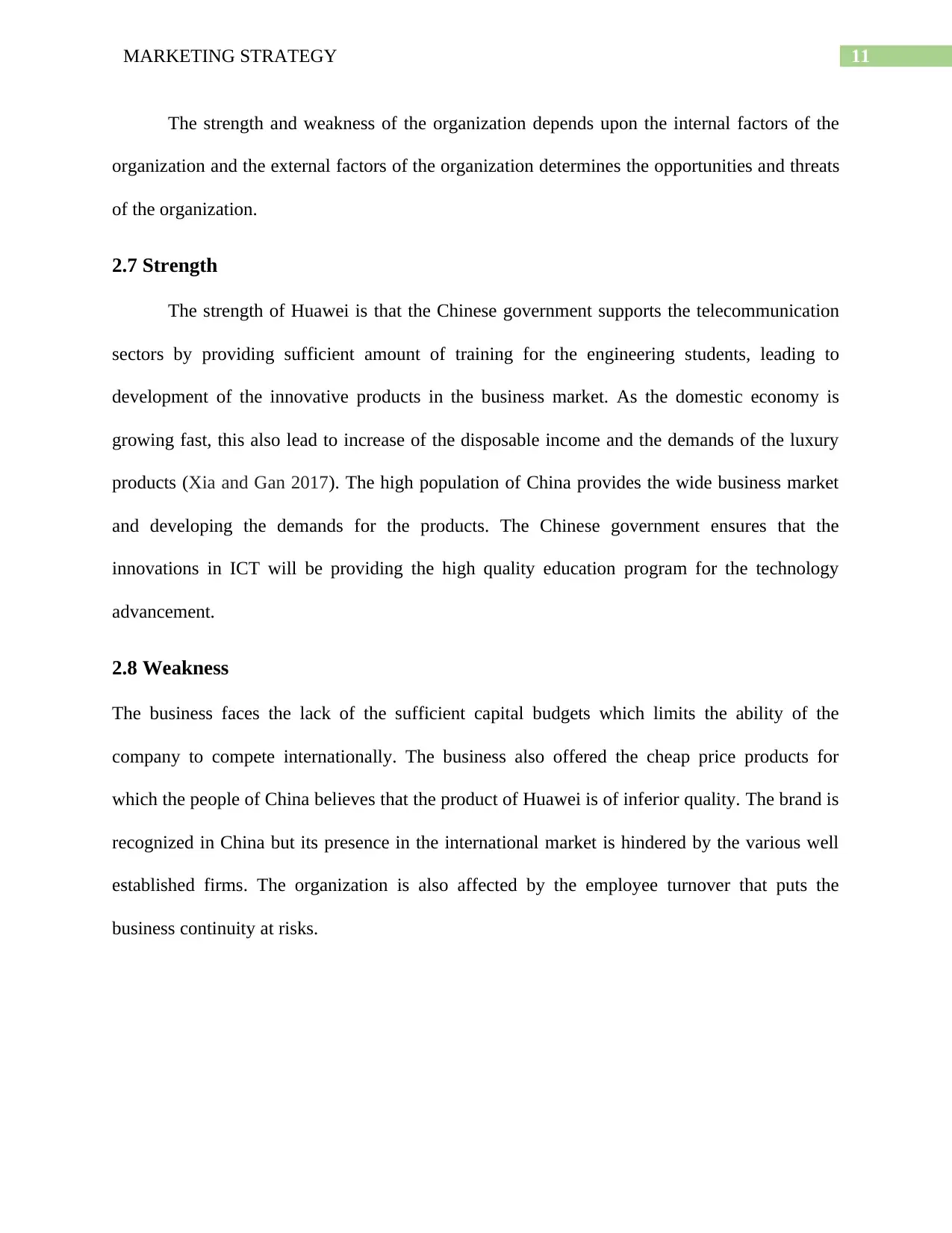
11MARKETING STRATEGY
The strength and weakness of the organization depends upon the internal factors of the
organization and the external factors of the organization determines the opportunities and threats
of the organization.
2.7 Strength
The strength of Huawei is that the Chinese government supports the telecommunication
sectors by providing sufficient amount of training for the engineering students, leading to
development of the innovative products in the business market. As the domestic economy is
growing fast, this also lead to increase of the disposable income and the demands of the luxury
products (Xia and Gan 2017). The high population of China provides the wide business market
and developing the demands for the products. The Chinese government ensures that the
innovations in ICT will be providing the high quality education program for the technology
advancement.
2.8 Weakness
The business faces the lack of the sufficient capital budgets which limits the ability of the
company to compete internationally. The business also offered the cheap price products for
which the people of China believes that the product of Huawei is of inferior quality. The brand is
recognized in China but its presence in the international market is hindered by the various well
established firms. The organization is also affected by the employee turnover that puts the
business continuity at risks.
The strength and weakness of the organization depends upon the internal factors of the
organization and the external factors of the organization determines the opportunities and threats
of the organization.
2.7 Strength
The strength of Huawei is that the Chinese government supports the telecommunication
sectors by providing sufficient amount of training for the engineering students, leading to
development of the innovative products in the business market. As the domestic economy is
growing fast, this also lead to increase of the disposable income and the demands of the luxury
products (Xia and Gan 2017). The high population of China provides the wide business market
and developing the demands for the products. The Chinese government ensures that the
innovations in ICT will be providing the high quality education program for the technology
advancement.
2.8 Weakness
The business faces the lack of the sufficient capital budgets which limits the ability of the
company to compete internationally. The business also offered the cheap price products for
which the people of China believes that the product of Huawei is of inferior quality. The brand is
recognized in China but its presence in the international market is hindered by the various well
established firms. The organization is also affected by the employee turnover that puts the
business continuity at risks.

12MARKETING STRATEGY
2.9 Opportunity
China is considered as the work serious as a result of its extensive populace. This offers
an incredible open door for Huawei is to eliminate the creation and the operational cost,
which thusly produces the propelled net revenue of the business. This outcomes in
minimal effort generation for managing the organizations that expands the item quality
without trading off its business edges. Huawei has the chance to profit by the
administration impetuses for creating the items which are aggressive in the worldwide
business advertise.
2.10 Threats
Huawei faces challenges in competing in the local business market with the international brands
as the international products dominates the market as they are well known in the business
market. While entering in the international business market the business is hindered by the
various regulations that exists in various countries. As the Chinese product is often found similar
with low quality but this is not applicable for every products. This image affects the penetration
of Huawei in the international market (Sun, Ding and Zhou 2016).
3.0 Competitive advantage (USP)
The unique selling proposition is considered as the feature for perceiving the benefit of
the goods that makes it unique from the competing brands in the market. One of the major
competitive advantage of Huawei is that the company produces the low cost products than the
other brands. The quality products are offered by the business in low cost that is that the
Huawei’s global contract sales for 2006 has reached 11 billion USD and 65% of which comes
from the overseas markets (Sun, Ding and Zhou 2016).
2.9 Opportunity
China is considered as the work serious as a result of its extensive populace. This offers
an incredible open door for Huawei is to eliminate the creation and the operational cost,
which thusly produces the propelled net revenue of the business. This outcomes in
minimal effort generation for managing the organizations that expands the item quality
without trading off its business edges. Huawei has the chance to profit by the
administration impetuses for creating the items which are aggressive in the worldwide
business advertise.
2.10 Threats
Huawei faces challenges in competing in the local business market with the international brands
as the international products dominates the market as they are well known in the business
market. While entering in the international business market the business is hindered by the
various regulations that exists in various countries. As the Chinese product is often found similar
with low quality but this is not applicable for every products. This image affects the penetration
of Huawei in the international market (Sun, Ding and Zhou 2016).
3.0 Competitive advantage (USP)
The unique selling proposition is considered as the feature for perceiving the benefit of
the goods that makes it unique from the competing brands in the market. One of the major
competitive advantage of Huawei is that the company produces the low cost products than the
other brands. The quality products are offered by the business in low cost that is that the
Huawei’s global contract sales for 2006 has reached 11 billion USD and 65% of which comes
from the overseas markets (Sun, Ding and Zhou 2016).
Paraphrase This Document
Need a fresh take? Get an instant paraphrase of this document with our AI Paraphraser
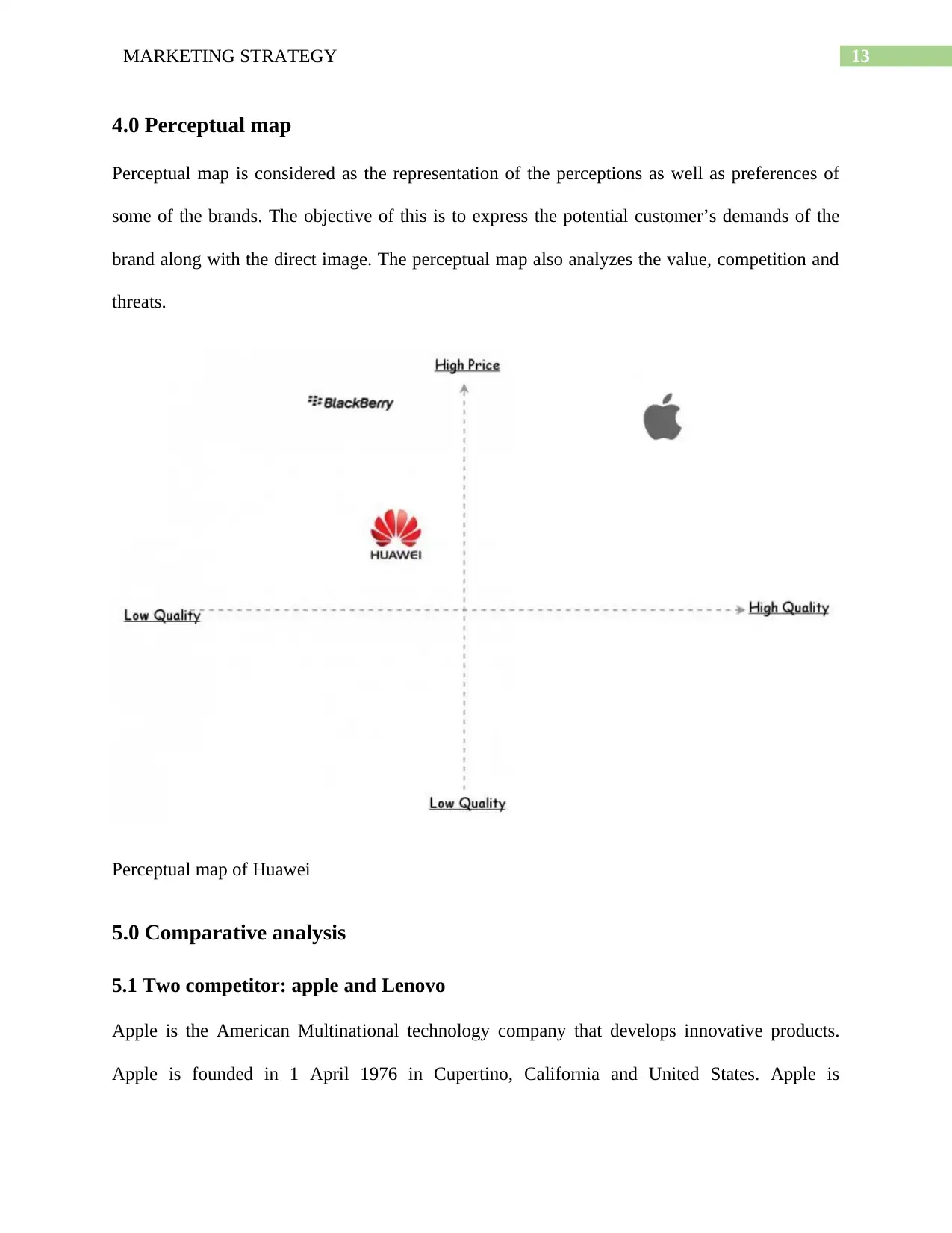
13MARKETING STRATEGY
4.0 Perceptual map
Perceptual map is considered as the representation of the perceptions as well as preferences of
some of the brands. The objective of this is to express the potential customer’s demands of the
brand along with the direct image. The perceptual map also analyzes the value, competition and
threats.
Perceptual map of Huawei
5.0 Comparative analysis
5.1 Two competitor: apple and Lenovo
Apple is the American Multinational technology company that develops innovative products.
Apple is founded in 1 April 1976 in Cupertino, California and United States. Apple is
4.0 Perceptual map
Perceptual map is considered as the representation of the perceptions as well as preferences of
some of the brands. The objective of this is to express the potential customer’s demands of the
brand along with the direct image. The perceptual map also analyzes the value, competition and
threats.
Perceptual map of Huawei
5.0 Comparative analysis
5.1 Two competitor: apple and Lenovo
Apple is the American Multinational technology company that develops innovative products.
Apple is founded in 1 April 1976 in Cupertino, California and United States. Apple is
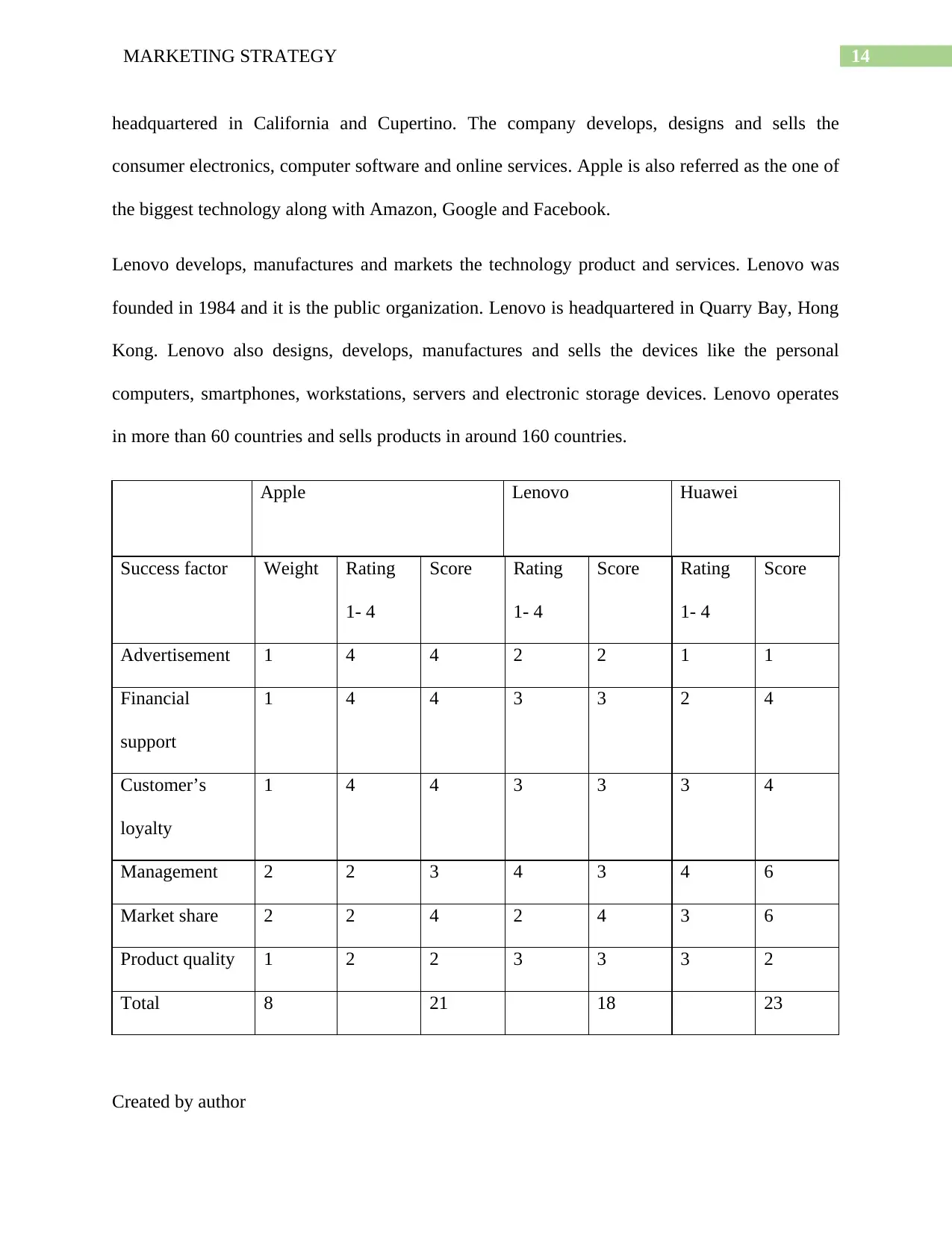
14MARKETING STRATEGY
headquartered in California and Cupertino. The company develops, designs and sells the
consumer electronics, computer software and online services. Apple is also referred as the one of
the biggest technology along with Amazon, Google and Facebook.
Lenovo develops, manufactures and markets the technology product and services. Lenovo was
founded in 1984 and it is the public organization. Lenovo is headquartered in Quarry Bay, Hong
Kong. Lenovo also designs, develops, manufactures and sells the devices like the personal
computers, smartphones, workstations, servers and electronic storage devices. Lenovo operates
in more than 60 countries and sells products in around 160 countries.
Apple Lenovo Huawei
Success factor Weight Rating
1- 4
Score Rating
1- 4
Score Rating
1- 4
Score
Advertisement 1 4 4 2 2 1 1
Financial
support
1 4 4 3 3 2 4
Customer’s
loyalty
1 4 4 3 3 3 4
Management 2 2 3 4 3 4 6
Market share 2 2 4 2 4 3 6
Product quality 1 2 2 3 3 3 2
Total 8 21 18 23
Created by author
headquartered in California and Cupertino. The company develops, designs and sells the
consumer electronics, computer software and online services. Apple is also referred as the one of
the biggest technology along with Amazon, Google and Facebook.
Lenovo develops, manufactures and markets the technology product and services. Lenovo was
founded in 1984 and it is the public organization. Lenovo is headquartered in Quarry Bay, Hong
Kong. Lenovo also designs, develops, manufactures and sells the devices like the personal
computers, smartphones, workstations, servers and electronic storage devices. Lenovo operates
in more than 60 countries and sells products in around 160 countries.
Apple Lenovo Huawei
Success factor Weight Rating
1- 4
Score Rating
1- 4
Score Rating
1- 4
Score
Advertisement 1 4 4 2 2 1 1
Financial
support
1 4 4 3 3 2 4
Customer’s
loyalty
1 4 4 3 3 3 4
Management 2 2 3 4 3 4 6
Market share 2 2 4 2 4 3 6
Product quality 1 2 2 3 3 3 2
Total 8 21 18 23
Created by author
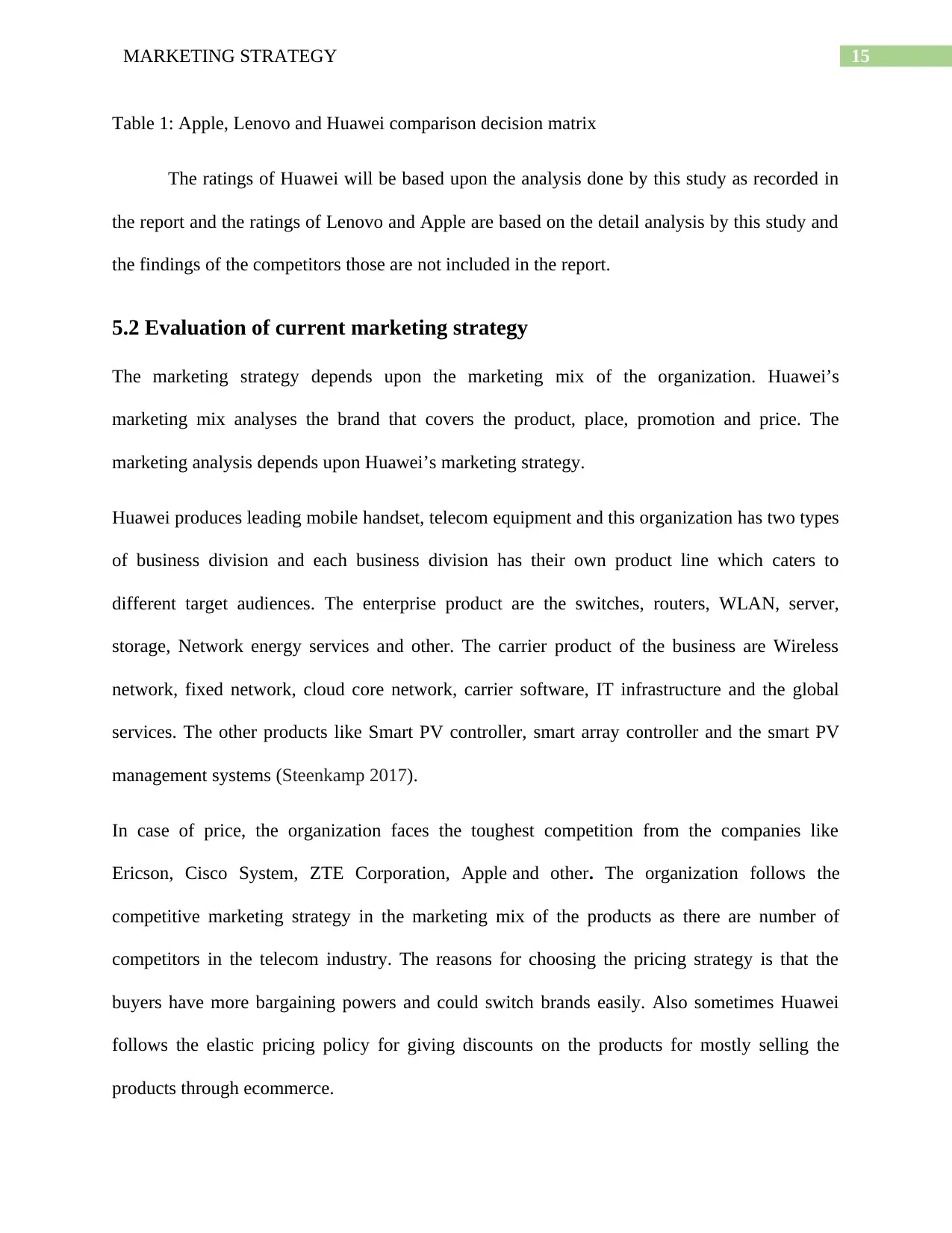
15MARKETING STRATEGY
Table 1: Apple, Lenovo and Huawei comparison decision matrix
The ratings of Huawei will be based upon the analysis done by this study as recorded in
the report and the ratings of Lenovo and Apple are based on the detail analysis by this study and
the findings of the competitors those are not included in the report.
5.2 Evaluation of current marketing strategy
The marketing strategy depends upon the marketing mix of the organization. Huawei’s
marketing mix analyses the brand that covers the product, place, promotion and price. The
marketing analysis depends upon Huawei’s marketing strategy.
Huawei produces leading mobile handset, telecom equipment and this organization has two types
of business division and each business division has their own product line which caters to
different target audiences. The enterprise product are the switches, routers, WLAN, server,
storage, Network energy services and other. The carrier product of the business are Wireless
network, fixed network, cloud core network, carrier software, IT infrastructure and the global
services. The other products like Smart PV controller, smart array controller and the smart PV
management systems (Steenkamp 2017).
In case of price, the organization faces the toughest competition from the companies like
Ericson, Cisco System, ZTE Corporation, Apple and other. The organization follows the
competitive marketing strategy in the marketing mix of the products as there are number of
competitors in the telecom industry. The reasons for choosing the pricing strategy is that the
buyers have more bargaining powers and could switch brands easily. Also sometimes Huawei
follows the elastic pricing policy for giving discounts on the products for mostly selling the
products through ecommerce.
Table 1: Apple, Lenovo and Huawei comparison decision matrix
The ratings of Huawei will be based upon the analysis done by this study as recorded in
the report and the ratings of Lenovo and Apple are based on the detail analysis by this study and
the findings of the competitors those are not included in the report.
5.2 Evaluation of current marketing strategy
The marketing strategy depends upon the marketing mix of the organization. Huawei’s
marketing mix analyses the brand that covers the product, place, promotion and price. The
marketing analysis depends upon Huawei’s marketing strategy.
Huawei produces leading mobile handset, telecom equipment and this organization has two types
of business division and each business division has their own product line which caters to
different target audiences. The enterprise product are the switches, routers, WLAN, server,
storage, Network energy services and other. The carrier product of the business are Wireless
network, fixed network, cloud core network, carrier software, IT infrastructure and the global
services. The other products like Smart PV controller, smart array controller and the smart PV
management systems (Steenkamp 2017).
In case of price, the organization faces the toughest competition from the companies like
Ericson, Cisco System, ZTE Corporation, Apple and other. The organization follows the
competitive marketing strategy in the marketing mix of the products as there are number of
competitors in the telecom industry. The reasons for choosing the pricing strategy is that the
buyers have more bargaining powers and could switch brands easily. Also sometimes Huawei
follows the elastic pricing policy for giving discounts on the products for mostly selling the
products through ecommerce.
Secure Best Marks with AI Grader
Need help grading? Try our AI Grader for instant feedback on your assignments.

16MARKETING STRATEGY
In case of place, the organization has its presence in more than 170 countries and along with the
telecom partners Huawei has built more than 1500 networks that serves more than 33% of the
world population. Huawei has also not been directly dealing with the customers and the newly
formed ventures between Huawei and the local authorities for building new channels for the
product distribution.
In case of promotion, Huawei uses up the Omni channel for promoting the brand and its product.
The company is also involved in the promotional activities for dealing with the marketing mix on
TV, radio, print, events and sponsorships. The company gets engaged in the various sponsoring
events and the sports team. Huawei also encourages various discount cards and coupons as the
part of the sales scheme.
In case of place, the organization has its presence in more than 170 countries and along with the
telecom partners Huawei has built more than 1500 networks that serves more than 33% of the
world population. Huawei has also not been directly dealing with the customers and the newly
formed ventures between Huawei and the local authorities for building new channels for the
product distribution.
In case of promotion, Huawei uses up the Omni channel for promoting the brand and its product.
The company is also involved in the promotional activities for dealing with the marketing mix on
TV, radio, print, events and sponsorships. The company gets engaged in the various sponsoring
events and the sports team. Huawei also encourages various discount cards and coupons as the
part of the sales scheme.

17MARKETING STRATEGY
6.0 Survey
6.0 Survey
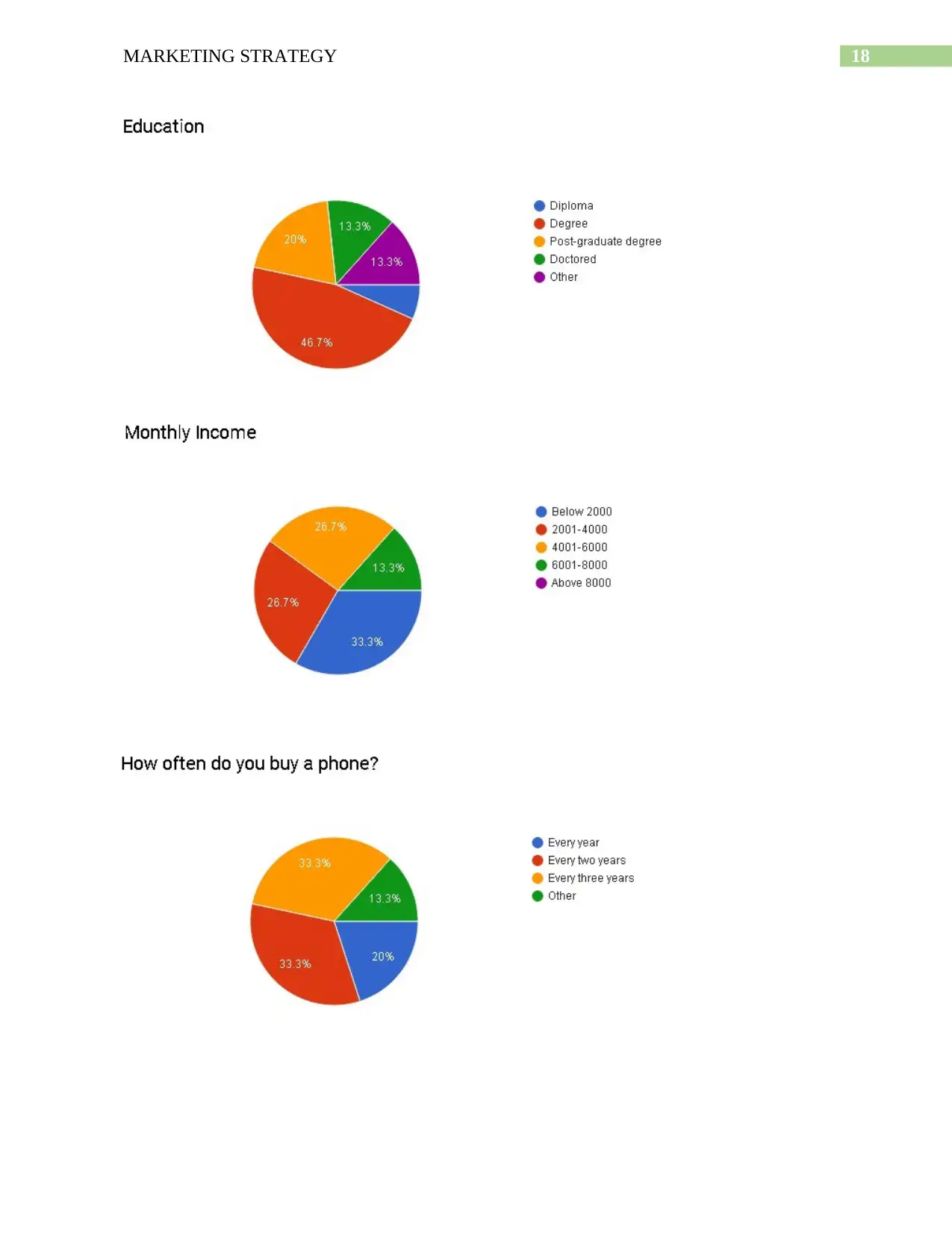
18MARKETING STRATEGY
Paraphrase This Document
Need a fresh take? Get an instant paraphrase of this document with our AI Paraphraser
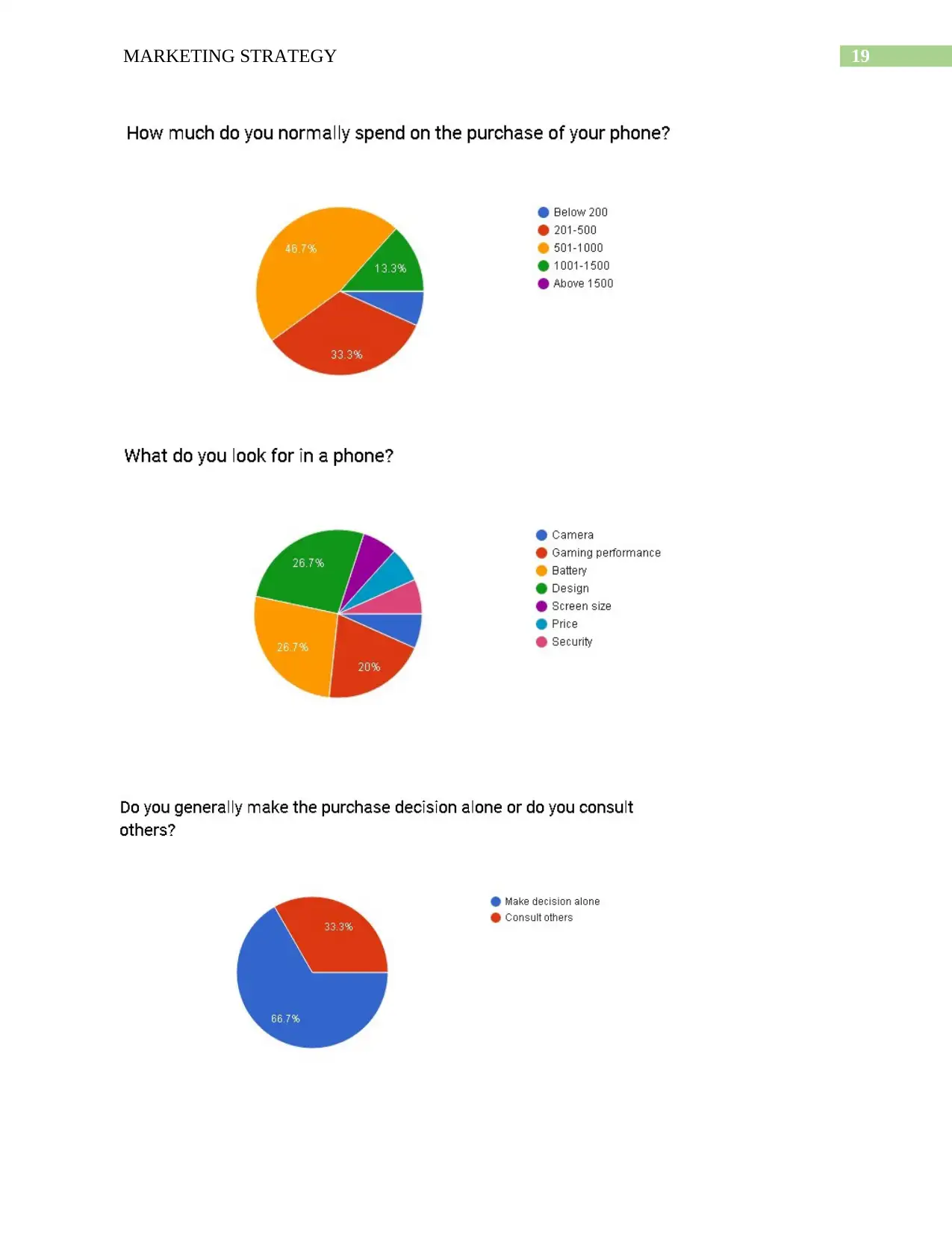
19MARKETING STRATEGY
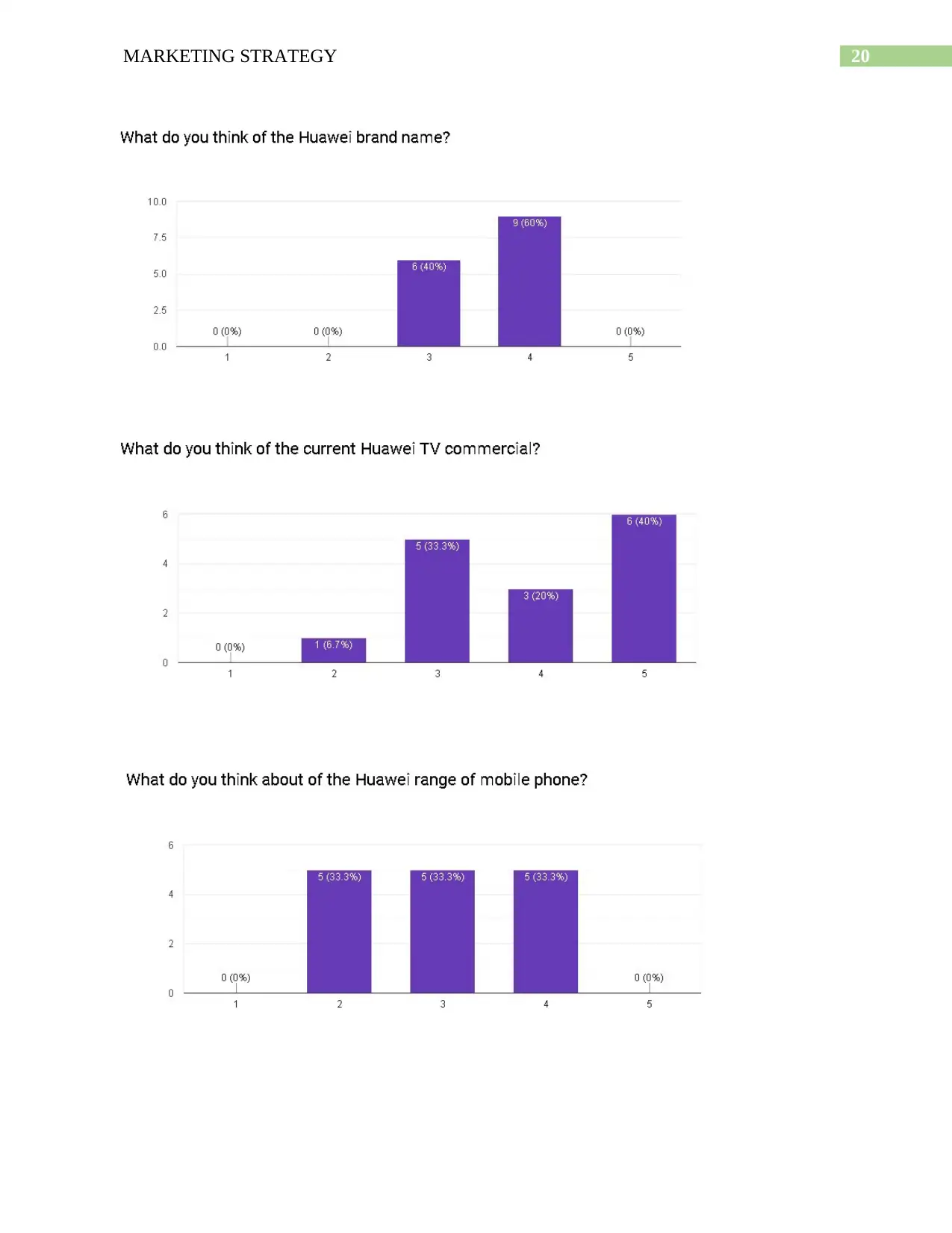
20MARKETING STRATEGY
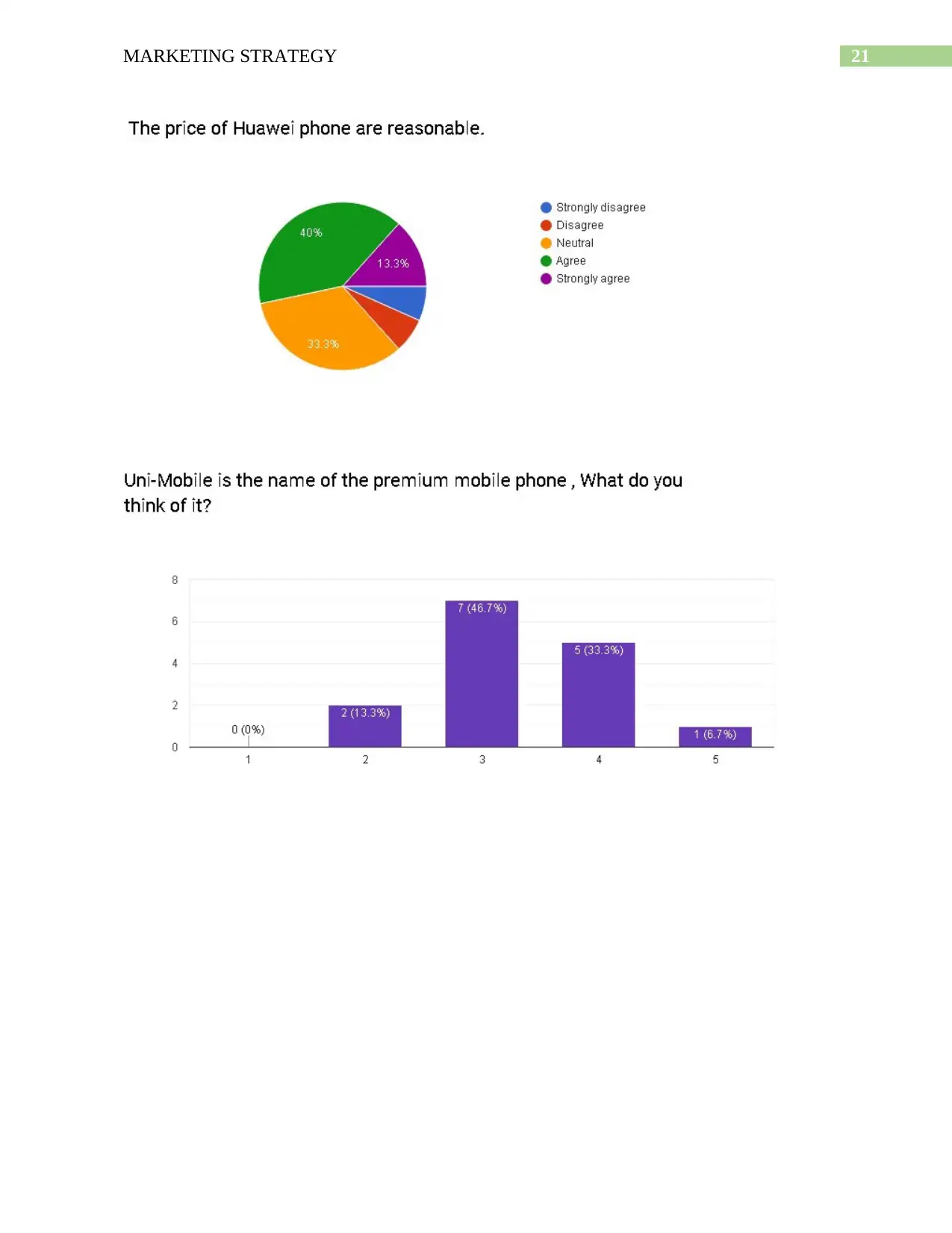
21MARKETING STRATEGY
Secure Best Marks with AI Grader
Need help grading? Try our AI Grader for instant feedback on your assignments.
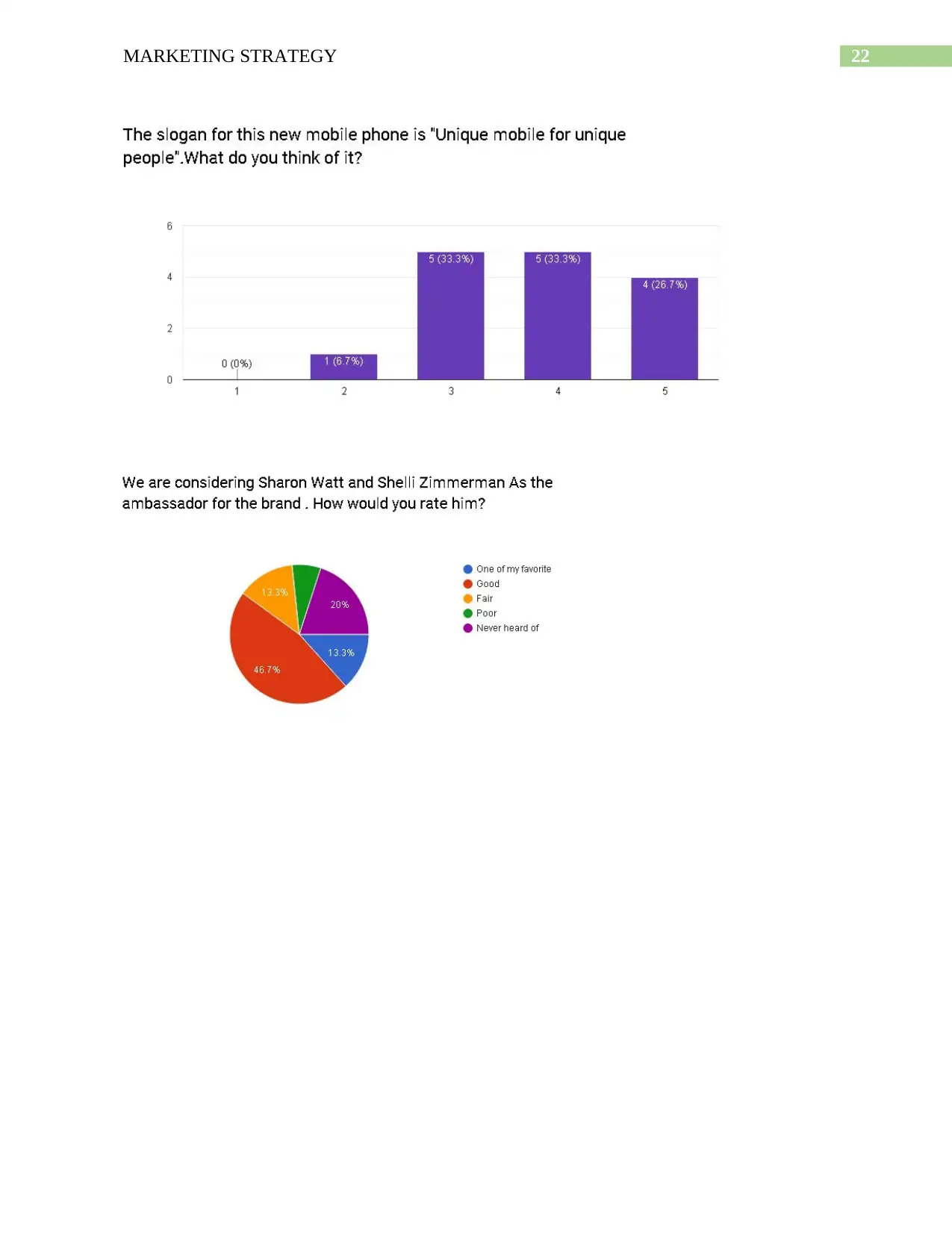
22MARKETING STRATEGY
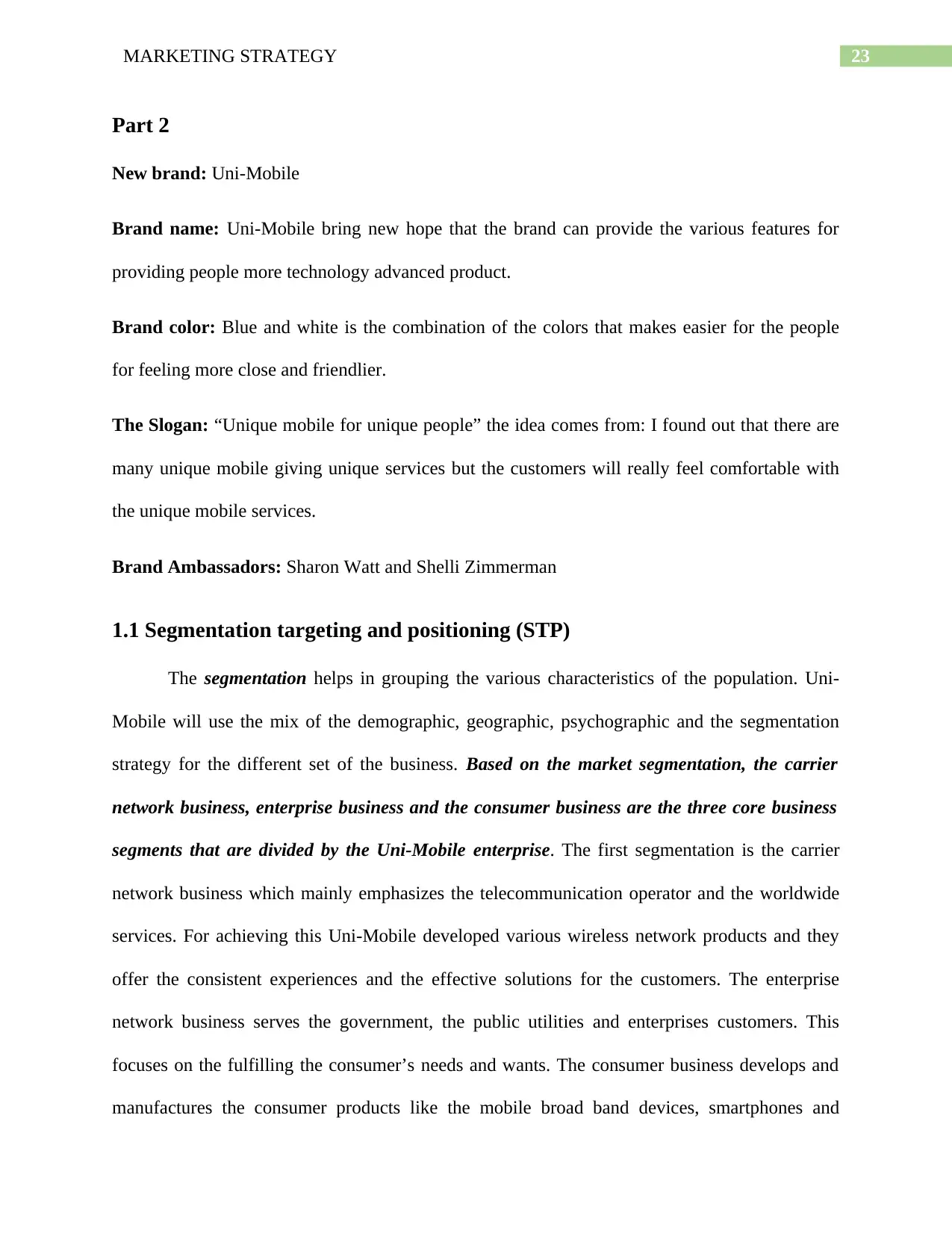
23MARKETING STRATEGY
Part 2
New brand: Uni-Mobile
Brand name: Uni-Mobile bring new hope that the brand can provide the various features for
providing people more technology advanced product.
Brand color: Blue and white is the combination of the colors that makes easier for the people
for feeling more close and friendlier.
The Slogan: “Unique mobile for unique people” the idea comes from: I found out that there are
many unique mobile giving unique services but the customers will really feel comfortable with
the unique mobile services.
Brand Ambassadors: Sharon Watt and Shelli Zimmerman
1.1 Segmentation targeting and positioning (STP)
The segmentation helps in grouping the various characteristics of the population. Uni-
Mobile will use the mix of the demographic, geographic, psychographic and the segmentation
strategy for the different set of the business. Based on the market segmentation, the carrier
network business, enterprise business and the consumer business are the three core business
segments that are divided by the Uni-Mobile enterprise. The first segmentation is the carrier
network business which mainly emphasizes the telecommunication operator and the worldwide
services. For achieving this Uni-Mobile developed various wireless network products and they
offer the consistent experiences and the effective solutions for the customers. The enterprise
network business serves the government, the public utilities and enterprises customers. This
focuses on the fulfilling the consumer’s needs and wants. The consumer business develops and
manufactures the consumer products like the mobile broad band devices, smartphones and
Part 2
New brand: Uni-Mobile
Brand name: Uni-Mobile bring new hope that the brand can provide the various features for
providing people more technology advanced product.
Brand color: Blue and white is the combination of the colors that makes easier for the people
for feeling more close and friendlier.
The Slogan: “Unique mobile for unique people” the idea comes from: I found out that there are
many unique mobile giving unique services but the customers will really feel comfortable with
the unique mobile services.
Brand Ambassadors: Sharon Watt and Shelli Zimmerman
1.1 Segmentation targeting and positioning (STP)
The segmentation helps in grouping the various characteristics of the population. Uni-
Mobile will use the mix of the demographic, geographic, psychographic and the segmentation
strategy for the different set of the business. Based on the market segmentation, the carrier
network business, enterprise business and the consumer business are the three core business
segments that are divided by the Uni-Mobile enterprise. The first segmentation is the carrier
network business which mainly emphasizes the telecommunication operator and the worldwide
services. For achieving this Uni-Mobile developed various wireless network products and they
offer the consistent experiences and the effective solutions for the customers. The enterprise
network business serves the government, the public utilities and enterprises customers. This
focuses on the fulfilling the consumer’s needs and wants. The consumer business develops and
manufactures the consumer products like the mobile broad band devices, smartphones and
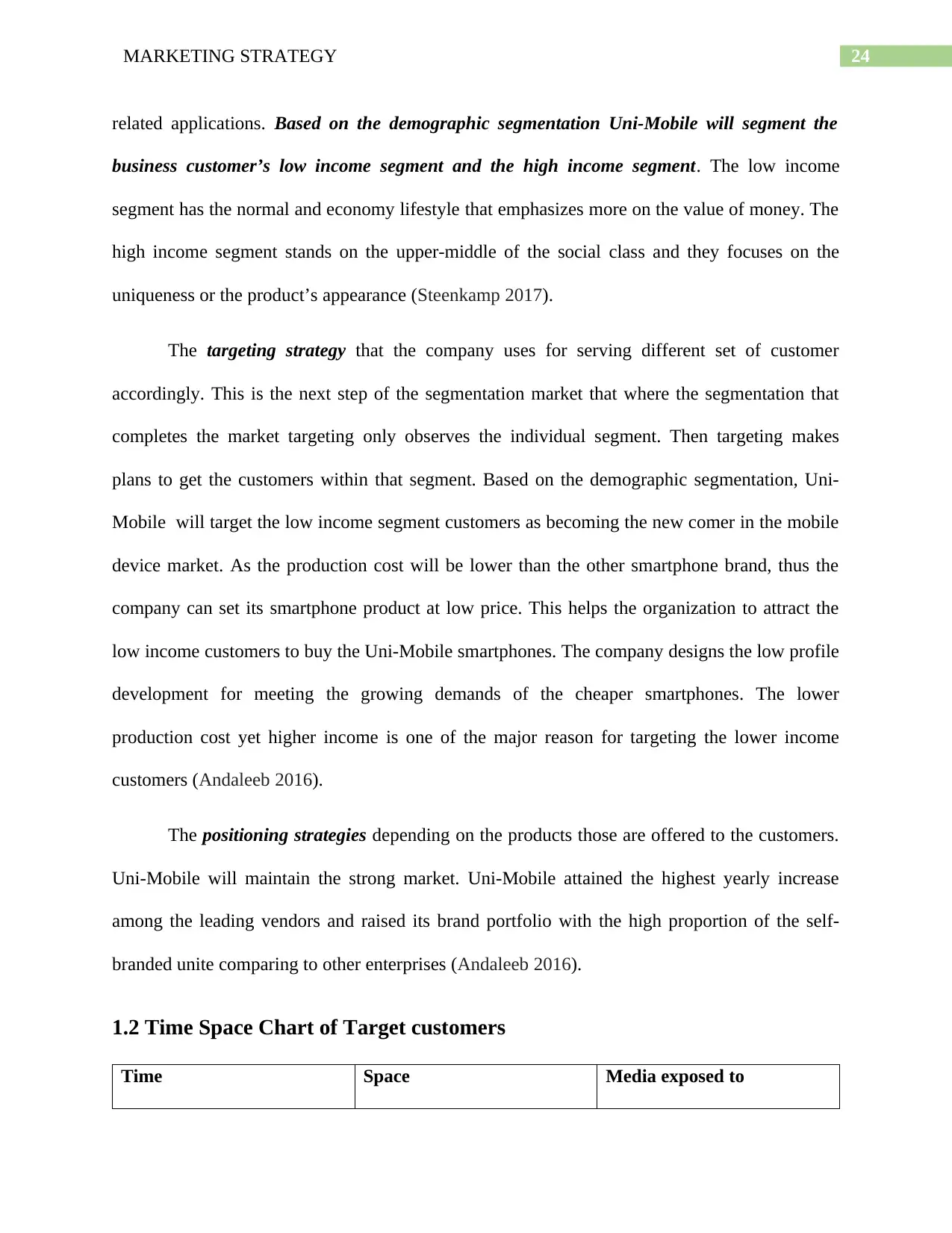
24MARKETING STRATEGY
related applications. Based on the demographic segmentation Uni-Mobile will segment the
business customer’s low income segment and the high income segment. The low income
segment has the normal and economy lifestyle that emphasizes more on the value of money. The
high income segment stands on the upper-middle of the social class and they focuses on the
uniqueness or the product’s appearance (Steenkamp 2017).
The targeting strategy that the company uses for serving different set of customer
accordingly. This is the next step of the segmentation market that where the segmentation that
completes the market targeting only observes the individual segment. Then targeting makes
plans to get the customers within that segment. Based on the demographic segmentation, Uni-
Mobile will target the low income segment customers as becoming the new comer in the mobile
device market. As the production cost will be lower than the other smartphone brand, thus the
company can set its smartphone product at low price. This helps the organization to attract the
low income customers to buy the Uni-Mobile smartphones. The company designs the low profile
development for meeting the growing demands of the cheaper smartphones. The lower
production cost yet higher income is one of the major reason for targeting the lower income
customers (Andaleeb 2016).
The positioning strategies depending on the products those are offered to the customers.
Uni-Mobile will maintain the strong market. Uni-Mobile attained the highest yearly increase
among the leading vendors and raised its brand portfolio with the high proportion of the self-
branded unite comparing to other enterprises (Andaleeb 2016).
1.2 Time Space Chart of Target customers
Time Space Media exposed to
related applications. Based on the demographic segmentation Uni-Mobile will segment the
business customer’s low income segment and the high income segment. The low income
segment has the normal and economy lifestyle that emphasizes more on the value of money. The
high income segment stands on the upper-middle of the social class and they focuses on the
uniqueness or the product’s appearance (Steenkamp 2017).
The targeting strategy that the company uses for serving different set of customer
accordingly. This is the next step of the segmentation market that where the segmentation that
completes the market targeting only observes the individual segment. Then targeting makes
plans to get the customers within that segment. Based on the demographic segmentation, Uni-
Mobile will target the low income segment customers as becoming the new comer in the mobile
device market. As the production cost will be lower than the other smartphone brand, thus the
company can set its smartphone product at low price. This helps the organization to attract the
low income customers to buy the Uni-Mobile smartphones. The company designs the low profile
development for meeting the growing demands of the cheaper smartphones. The lower
production cost yet higher income is one of the major reason for targeting the lower income
customers (Andaleeb 2016).
The positioning strategies depending on the products those are offered to the customers.
Uni-Mobile will maintain the strong market. Uni-Mobile attained the highest yearly increase
among the leading vendors and raised its brand portfolio with the high proportion of the self-
branded unite comparing to other enterprises (Andaleeb 2016).
1.2 Time Space Chart of Target customers
Time Space Media exposed to
Paraphrase This Document
Need a fresh take? Get an instant paraphrase of this document with our AI Paraphraser
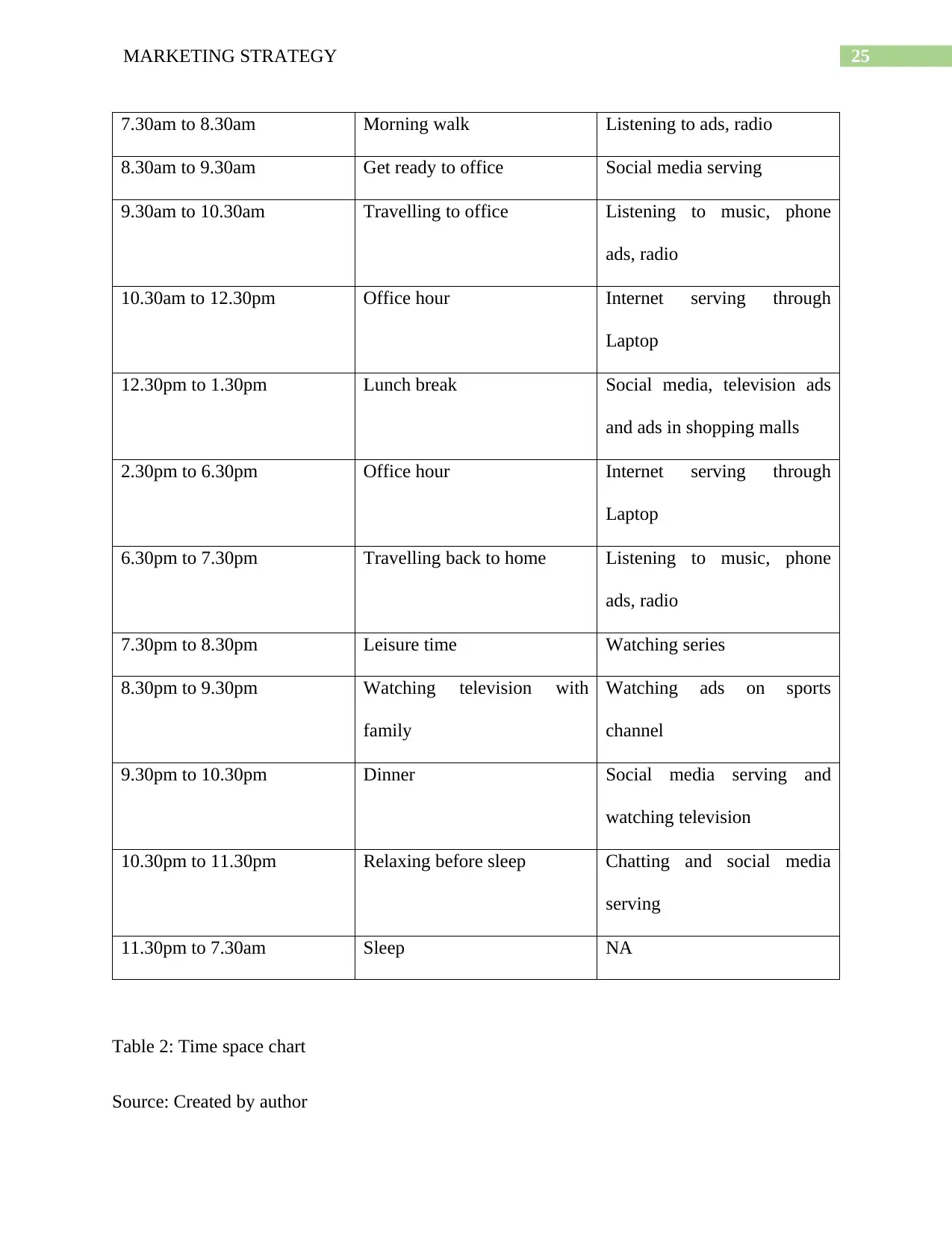
25MARKETING STRATEGY
7.30am to 8.30am Morning walk Listening to ads, radio
8.30am to 9.30am Get ready to office Social media serving
9.30am to 10.30am Travelling to office Listening to music, phone
ads, radio
10.30am to 12.30pm Office hour Internet serving through
Laptop
12.30pm to 1.30pm Lunch break Social media, television ads
and ads in shopping malls
2.30pm to 6.30pm Office hour Internet serving through
Laptop
6.30pm to 7.30pm Travelling back to home Listening to music, phone
ads, radio
7.30pm to 8.30pm Leisure time Watching series
8.30pm to 9.30pm Watching television with
family
Watching ads on sports
channel
9.30pm to 10.30pm Dinner Social media serving and
watching television
10.30pm to 11.30pm Relaxing before sleep Chatting and social media
serving
11.30pm to 7.30am Sleep NA
Table 2: Time space chart
Source: Created by author
7.30am to 8.30am Morning walk Listening to ads, radio
8.30am to 9.30am Get ready to office Social media serving
9.30am to 10.30am Travelling to office Listening to music, phone
ads, radio
10.30am to 12.30pm Office hour Internet serving through
Laptop
12.30pm to 1.30pm Lunch break Social media, television ads
and ads in shopping malls
2.30pm to 6.30pm Office hour Internet serving through
Laptop
6.30pm to 7.30pm Travelling back to home Listening to music, phone
ads, radio
7.30pm to 8.30pm Leisure time Watching series
8.30pm to 9.30pm Watching television with
family
Watching ads on sports
channel
9.30pm to 10.30pm Dinner Social media serving and
watching television
10.30pm to 11.30pm Relaxing before sleep Chatting and social media
serving
11.30pm to 7.30am Sleep NA
Table 2: Time space chart
Source: Created by author
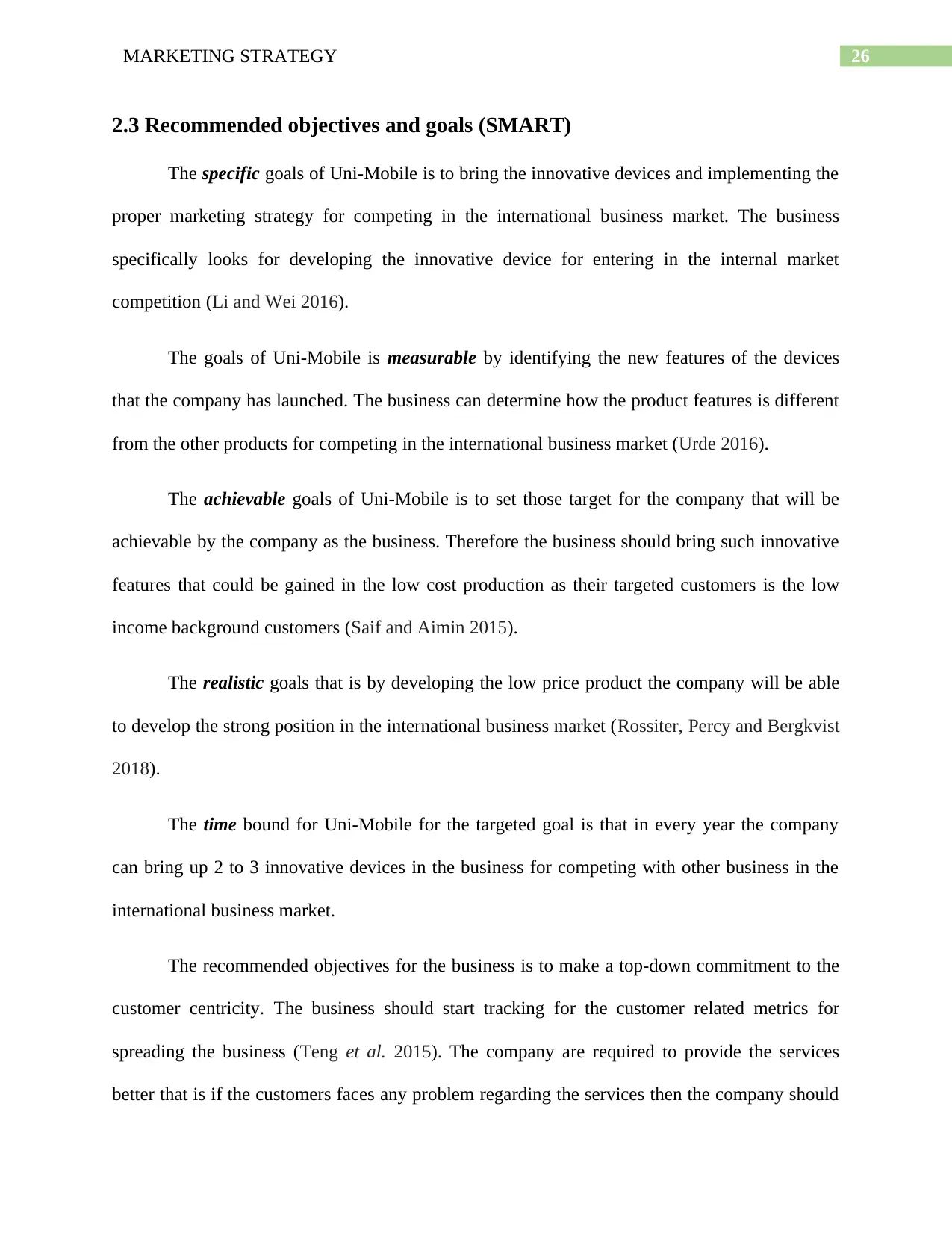
26MARKETING STRATEGY
2.3 Recommended objectives and goals (SMART)
The specific goals of Uni-Mobile is to bring the innovative devices and implementing the
proper marketing strategy for competing in the international business market. The business
specifically looks for developing the innovative device for entering in the internal market
competition (Li and Wei 2016).
The goals of Uni-Mobile is measurable by identifying the new features of the devices
that the company has launched. The business can determine how the product features is different
from the other products for competing in the international business market (Urde 2016).
The achievable goals of Uni-Mobile is to set those target for the company that will be
achievable by the company as the business. Therefore the business should bring such innovative
features that could be gained in the low cost production as their targeted customers is the low
income background customers (Saif and Aimin 2015).
The realistic goals that is by developing the low price product the company will be able
to develop the strong position in the international business market (Rossiter, Percy and Bergkvist
2018).
The time bound for Uni-Mobile for the targeted goal is that in every year the company
can bring up 2 to 3 innovative devices in the business for competing with other business in the
international business market.
The recommended objectives for the business is to make a top-down commitment to the
customer centricity. The business should start tracking for the customer related metrics for
spreading the business (Teng et al. 2015). The company are required to provide the services
better that is if the customers faces any problem regarding the services then the company should
2.3 Recommended objectives and goals (SMART)
The specific goals of Uni-Mobile is to bring the innovative devices and implementing the
proper marketing strategy for competing in the international business market. The business
specifically looks for developing the innovative device for entering in the internal market
competition (Li and Wei 2016).
The goals of Uni-Mobile is measurable by identifying the new features of the devices
that the company has launched. The business can determine how the product features is different
from the other products for competing in the international business market (Urde 2016).
The achievable goals of Uni-Mobile is to set those target for the company that will be
achievable by the company as the business. Therefore the business should bring such innovative
features that could be gained in the low cost production as their targeted customers is the low
income background customers (Saif and Aimin 2015).
The realistic goals that is by developing the low price product the company will be able
to develop the strong position in the international business market (Rossiter, Percy and Bergkvist
2018).
The time bound for Uni-Mobile for the targeted goal is that in every year the company
can bring up 2 to 3 innovative devices in the business for competing with other business in the
international business market.
The recommended objectives for the business is to make a top-down commitment to the
customer centricity. The business should start tracking for the customer related metrics for
spreading the business (Teng et al. 2015). The company are required to provide the services
better that is if the customers faces any problem regarding the services then the company should
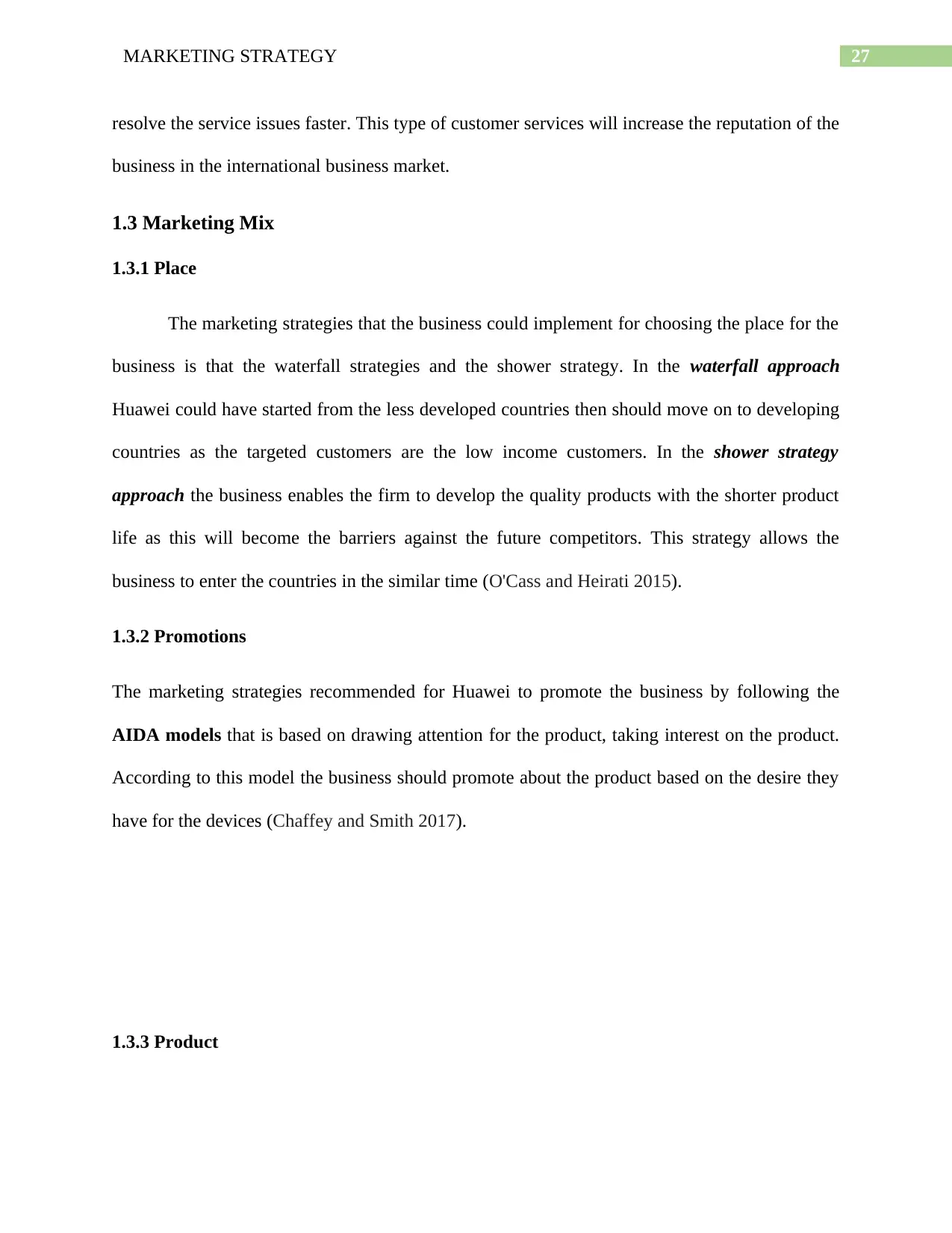
27MARKETING STRATEGY
resolve the service issues faster. This type of customer services will increase the reputation of the
business in the international business market.
1.3 Marketing Mix
1.3.1 Place
The marketing strategies that the business could implement for choosing the place for the
business is that the waterfall strategies and the shower strategy. In the waterfall approach
Huawei could have started from the less developed countries then should move on to developing
countries as the targeted customers are the low income customers. In the shower strategy
approach the business enables the firm to develop the quality products with the shorter product
life as this will become the barriers against the future competitors. This strategy allows the
business to enter the countries in the similar time (O'Cass and Heirati 2015).
1.3.2 Promotions
The marketing strategies recommended for Huawei to promote the business by following the
AIDA models that is based on drawing attention for the product, taking interest on the product.
According to this model the business should promote about the product based on the desire they
have for the devices (Chaffey and Smith 2017).
1.3.3 Product
resolve the service issues faster. This type of customer services will increase the reputation of the
business in the international business market.
1.3 Marketing Mix
1.3.1 Place
The marketing strategies that the business could implement for choosing the place for the
business is that the waterfall strategies and the shower strategy. In the waterfall approach
Huawei could have started from the less developed countries then should move on to developing
countries as the targeted customers are the low income customers. In the shower strategy
approach the business enables the firm to develop the quality products with the shorter product
life as this will become the barriers against the future competitors. This strategy allows the
business to enter the countries in the similar time (O'Cass and Heirati 2015).
1.3.2 Promotions
The marketing strategies recommended for Huawei to promote the business by following the
AIDA models that is based on drawing attention for the product, taking interest on the product.
According to this model the business should promote about the product based on the desire they
have for the devices (Chaffey and Smith 2017).
1.3.3 Product
Secure Best Marks with AI Grader
Need help grading? Try our AI Grader for instant feedback on your assignments.
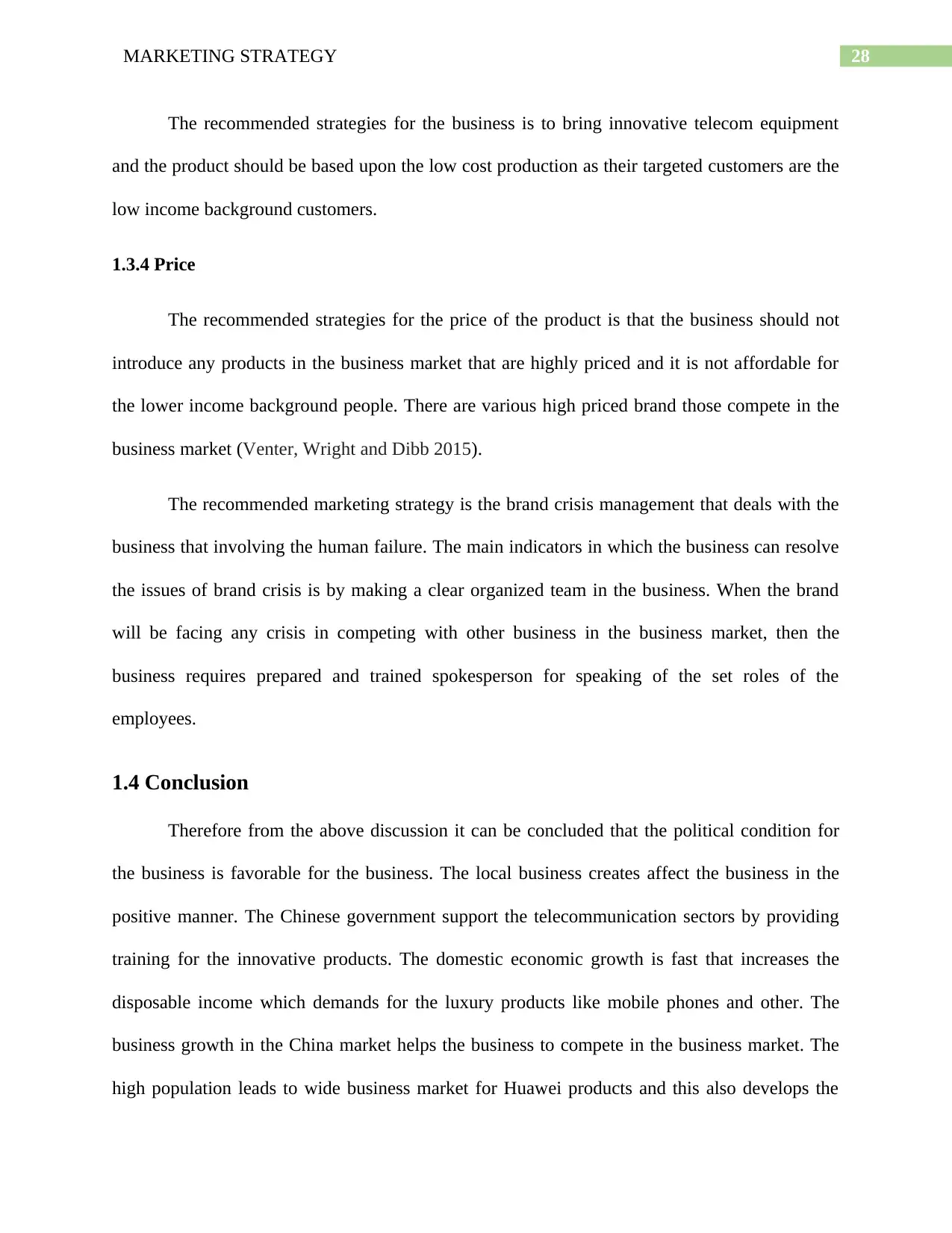
28MARKETING STRATEGY
The recommended strategies for the business is to bring innovative telecom equipment
and the product should be based upon the low cost production as their targeted customers are the
low income background customers.
1.3.4 Price
The recommended strategies for the price of the product is that the business should not
introduce any products in the business market that are highly priced and it is not affordable for
the lower income background people. There are various high priced brand those compete in the
business market (Venter, Wright and Dibb 2015).
The recommended marketing strategy is the brand crisis management that deals with the
business that involving the human failure. The main indicators in which the business can resolve
the issues of brand crisis is by making a clear organized team in the business. When the brand
will be facing any crisis in competing with other business in the business market, then the
business requires prepared and trained spokesperson for speaking of the set roles of the
employees.
1.4 Conclusion
Therefore from the above discussion it can be concluded that the political condition for
the business is favorable for the business. The local business creates affect the business in the
positive manner. The Chinese government support the telecommunication sectors by providing
training for the innovative products. The domestic economic growth is fast that increases the
disposable income which demands for the luxury products like mobile phones and other. The
business growth in the China market helps the business to compete in the business market. The
high population leads to wide business market for Huawei products and this also develops the
The recommended strategies for the business is to bring innovative telecom equipment
and the product should be based upon the low cost production as their targeted customers are the
low income background customers.
1.3.4 Price
The recommended strategies for the price of the product is that the business should not
introduce any products in the business market that are highly priced and it is not affordable for
the lower income background people. There are various high priced brand those compete in the
business market (Venter, Wright and Dibb 2015).
The recommended marketing strategy is the brand crisis management that deals with the
business that involving the human failure. The main indicators in which the business can resolve
the issues of brand crisis is by making a clear organized team in the business. When the brand
will be facing any crisis in competing with other business in the business market, then the
business requires prepared and trained spokesperson for speaking of the set roles of the
employees.
1.4 Conclusion
Therefore from the above discussion it can be concluded that the political condition for
the business is favorable for the business. The local business creates affect the business in the
positive manner. The Chinese government support the telecommunication sectors by providing
training for the innovative products. The domestic economic growth is fast that increases the
disposable income which demands for the luxury products like mobile phones and other. The
business growth in the China market helps the business to compete in the business market. The
high population leads to wide business market for Huawei products and this also develops the

29MARKETING STRATEGY
steep demands for the products. The technology advancement helps the business to bring
innovative products in the business market with new features. The company wastes are used up
for cutting the possible wages by maximizing the available materials. The business operations is
based on the legal laws like the patent acts, tax rates, labor laws and the environmental laws.
This study also analyses the competitive advantages and the present marketing strategy of the
organization. The second part analyses the segmentations made by Huawei, the targets for the
organization and the market position of the organization. This study recommends the strategies
based on the marketing mix of Huawei.
steep demands for the products. The technology advancement helps the business to bring
innovative products in the business market with new features. The company wastes are used up
for cutting the possible wages by maximizing the available materials. The business operations is
based on the legal laws like the patent acts, tax rates, labor laws and the environmental laws.
This study also analyses the competitive advantages and the present marketing strategy of the
organization. The second part analyses the segmentations made by Huawei, the targets for the
organization and the market position of the organization. This study recommends the strategies
based on the marketing mix of Huawei.
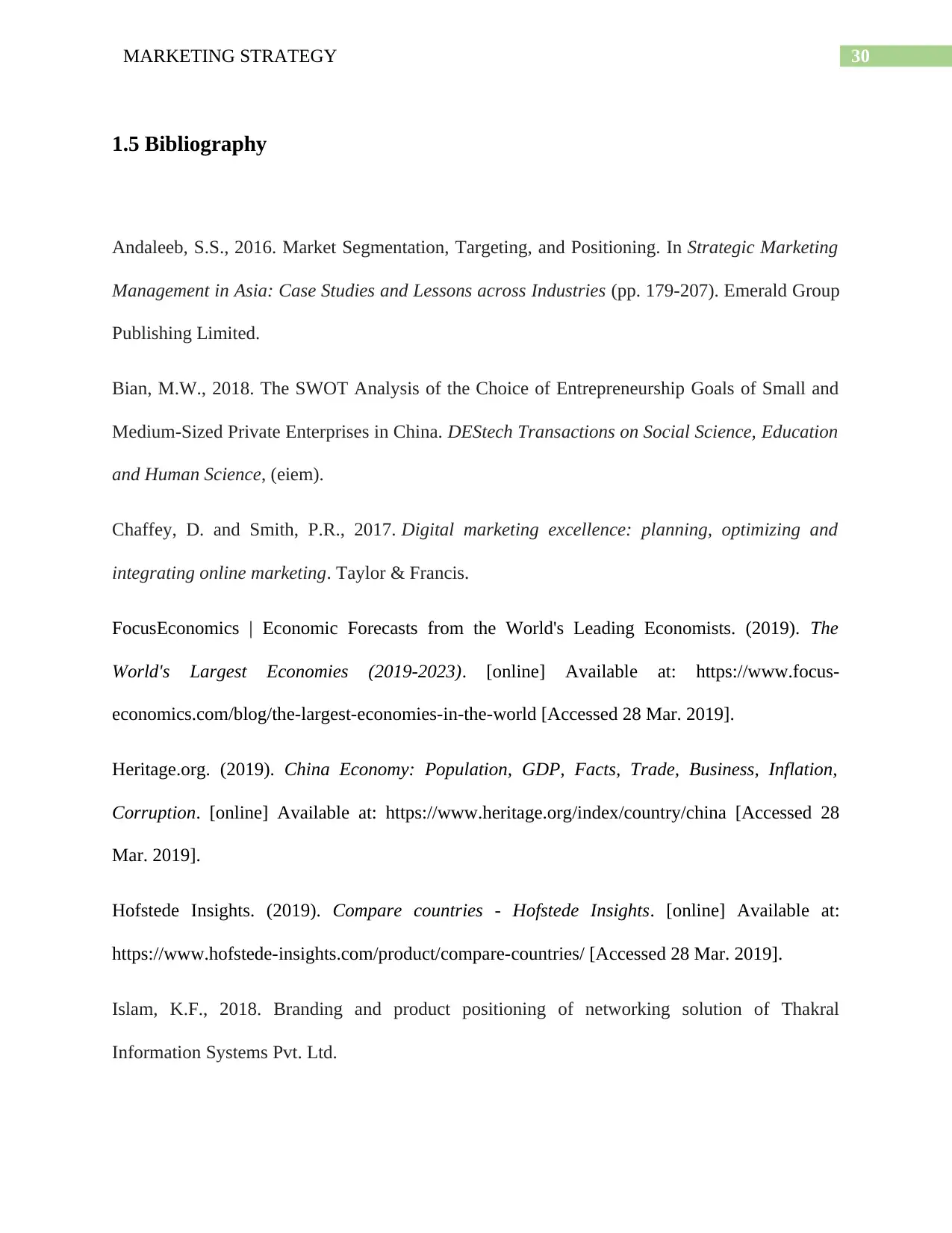
30MARKETING STRATEGY
1.5 Bibliography
Andaleeb, S.S., 2016. Market Segmentation, Targeting, and Positioning. In Strategic Marketing
Management in Asia: Case Studies and Lessons across Industries (pp. 179-207). Emerald Group
Publishing Limited.
Bian, M.W., 2018. The SWOT Analysis of the Choice of Entrepreneurship Goals of Small and
Medium-Sized Private Enterprises in China. DEStech Transactions on Social Science, Education
and Human Science, (eiem).
Chaffey, D. and Smith, P.R., 2017. Digital marketing excellence: planning, optimizing and
integrating online marketing. Taylor & Francis.
FocusEconomics | Economic Forecasts from the World's Leading Economists. (2019). The
World's Largest Economies (2019-2023). [online] Available at: https://www.focus-
economics.com/blog/the-largest-economies-in-the-world [Accessed 28 Mar. 2019].
Heritage.org. (2019). China Economy: Population, GDP, Facts, Trade, Business, Inflation,
Corruption. [online] Available at: https://www.heritage.org/index/country/china [Accessed 28
Mar. 2019].
Hofstede Insights. (2019). Compare countries - Hofstede Insights. [online] Available at:
https://www.hofstede-insights.com/product/compare-countries/ [Accessed 28 Mar. 2019].
Islam, K.F., 2018. Branding and product positioning of networking solution of Thakral
Information Systems Pvt. Ltd.
1.5 Bibliography
Andaleeb, S.S., 2016. Market Segmentation, Targeting, and Positioning. In Strategic Marketing
Management in Asia: Case Studies and Lessons across Industries (pp. 179-207). Emerald Group
Publishing Limited.
Bian, M.W., 2018. The SWOT Analysis of the Choice of Entrepreneurship Goals of Small and
Medium-Sized Private Enterprises in China. DEStech Transactions on Social Science, Education
and Human Science, (eiem).
Chaffey, D. and Smith, P.R., 2017. Digital marketing excellence: planning, optimizing and
integrating online marketing. Taylor & Francis.
FocusEconomics | Economic Forecasts from the World's Leading Economists. (2019). The
World's Largest Economies (2019-2023). [online] Available at: https://www.focus-
economics.com/blog/the-largest-economies-in-the-world [Accessed 28 Mar. 2019].
Heritage.org. (2019). China Economy: Population, GDP, Facts, Trade, Business, Inflation,
Corruption. [online] Available at: https://www.heritage.org/index/country/china [Accessed 28
Mar. 2019].
Hofstede Insights. (2019). Compare countries - Hofstede Insights. [online] Available at:
https://www.hofstede-insights.com/product/compare-countries/ [Accessed 28 Mar. 2019].
Islam, K.F., 2018. Branding and product positioning of networking solution of Thakral
Information Systems Pvt. Ltd.
Paraphrase This Document
Need a fresh take? Get an instant paraphrase of this document with our AI Paraphraser
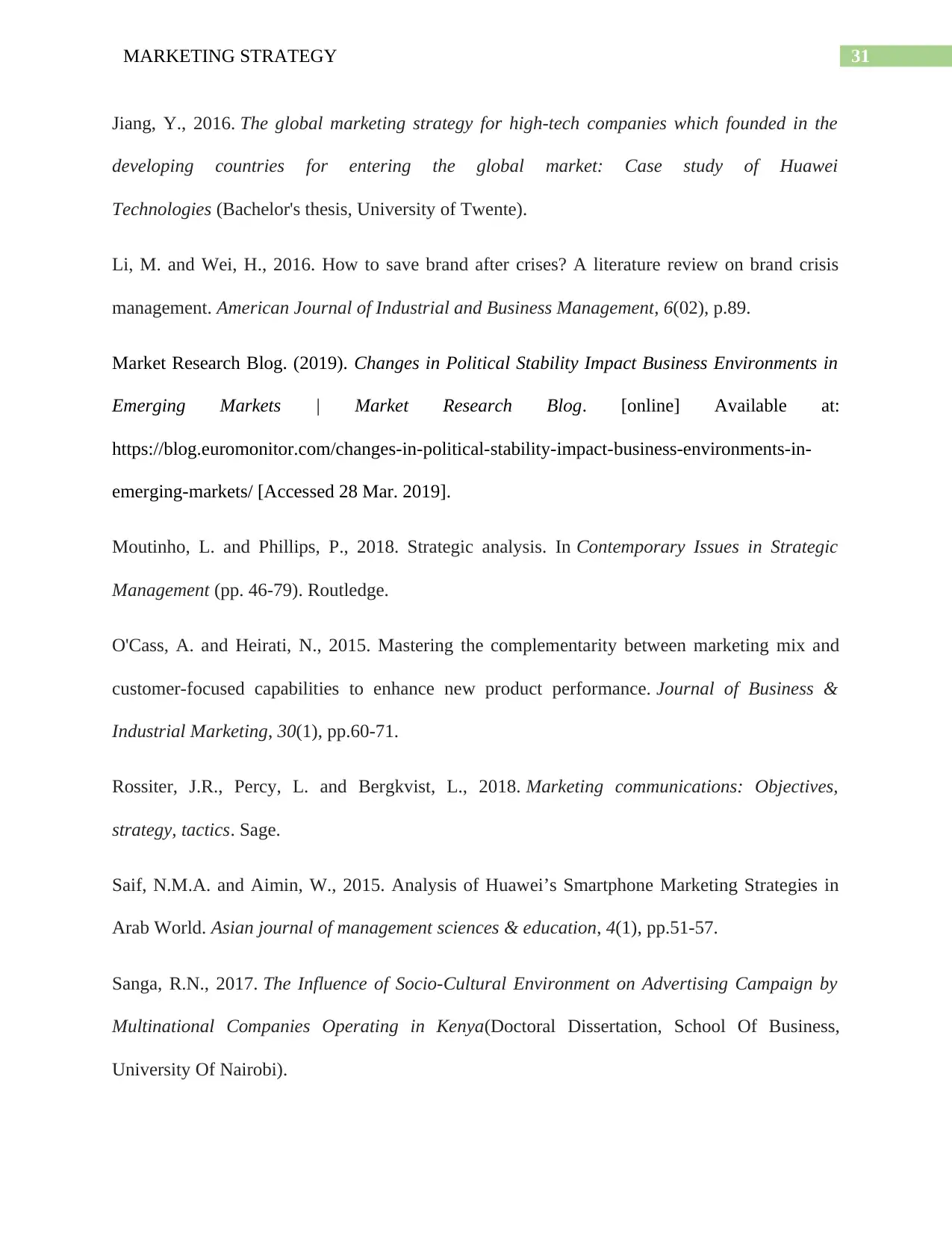
31MARKETING STRATEGY
Jiang, Y., 2016. The global marketing strategy for high-tech companies which founded in the
developing countries for entering the global market: Case study of Huawei
Technologies (Bachelor's thesis, University of Twente).
Li, M. and Wei, H., 2016. How to save brand after crises? A literature review on brand crisis
management. American Journal of Industrial and Business Management, 6(02), p.89.
Market Research Blog. (2019). Changes in Political Stability Impact Business Environments in
Emerging Markets | Market Research Blog. [online] Available at:
https://blog.euromonitor.com/changes-in-political-stability-impact-business-environments-in-
emerging-markets/ [Accessed 28 Mar. 2019].
Moutinho, L. and Phillips, P., 2018. Strategic analysis. In Contemporary Issues in Strategic
Management (pp. 46-79). Routledge.
O'Cass, A. and Heirati, N., 2015. Mastering the complementarity between marketing mix and
customer-focused capabilities to enhance new product performance. Journal of Business &
Industrial Marketing, 30(1), pp.60-71.
Rossiter, J.R., Percy, L. and Bergkvist, L., 2018. Marketing communications: Objectives,
strategy, tactics. Sage.
Saif, N.M.A. and Aimin, W., 2015. Analysis of Huawei’s Smartphone Marketing Strategies in
Arab World. Asian journal of management sciences & education, 4(1), pp.51-57.
Sanga, R.N., 2017. The Influence of Socio-Cultural Environment on Advertising Campaign by
Multinational Companies Operating in Kenya(Doctoral Dissertation, School Of Business,
University Of Nairobi).
Jiang, Y., 2016. The global marketing strategy for high-tech companies which founded in the
developing countries for entering the global market: Case study of Huawei
Technologies (Bachelor's thesis, University of Twente).
Li, M. and Wei, H., 2016. How to save brand after crises? A literature review on brand crisis
management. American Journal of Industrial and Business Management, 6(02), p.89.
Market Research Blog. (2019). Changes in Political Stability Impact Business Environments in
Emerging Markets | Market Research Blog. [online] Available at:
https://blog.euromonitor.com/changes-in-political-stability-impact-business-environments-in-
emerging-markets/ [Accessed 28 Mar. 2019].
Moutinho, L. and Phillips, P., 2018. Strategic analysis. In Contemporary Issues in Strategic
Management (pp. 46-79). Routledge.
O'Cass, A. and Heirati, N., 2015. Mastering the complementarity between marketing mix and
customer-focused capabilities to enhance new product performance. Journal of Business &
Industrial Marketing, 30(1), pp.60-71.
Rossiter, J.R., Percy, L. and Bergkvist, L., 2018. Marketing communications: Objectives,
strategy, tactics. Sage.
Saif, N.M.A. and Aimin, W., 2015. Analysis of Huawei’s Smartphone Marketing Strategies in
Arab World. Asian journal of management sciences & education, 4(1), pp.51-57.
Sanga, R.N., 2017. The Influence of Socio-Cultural Environment on Advertising Campaign by
Multinational Companies Operating in Kenya(Doctoral Dissertation, School Of Business,
University Of Nairobi).
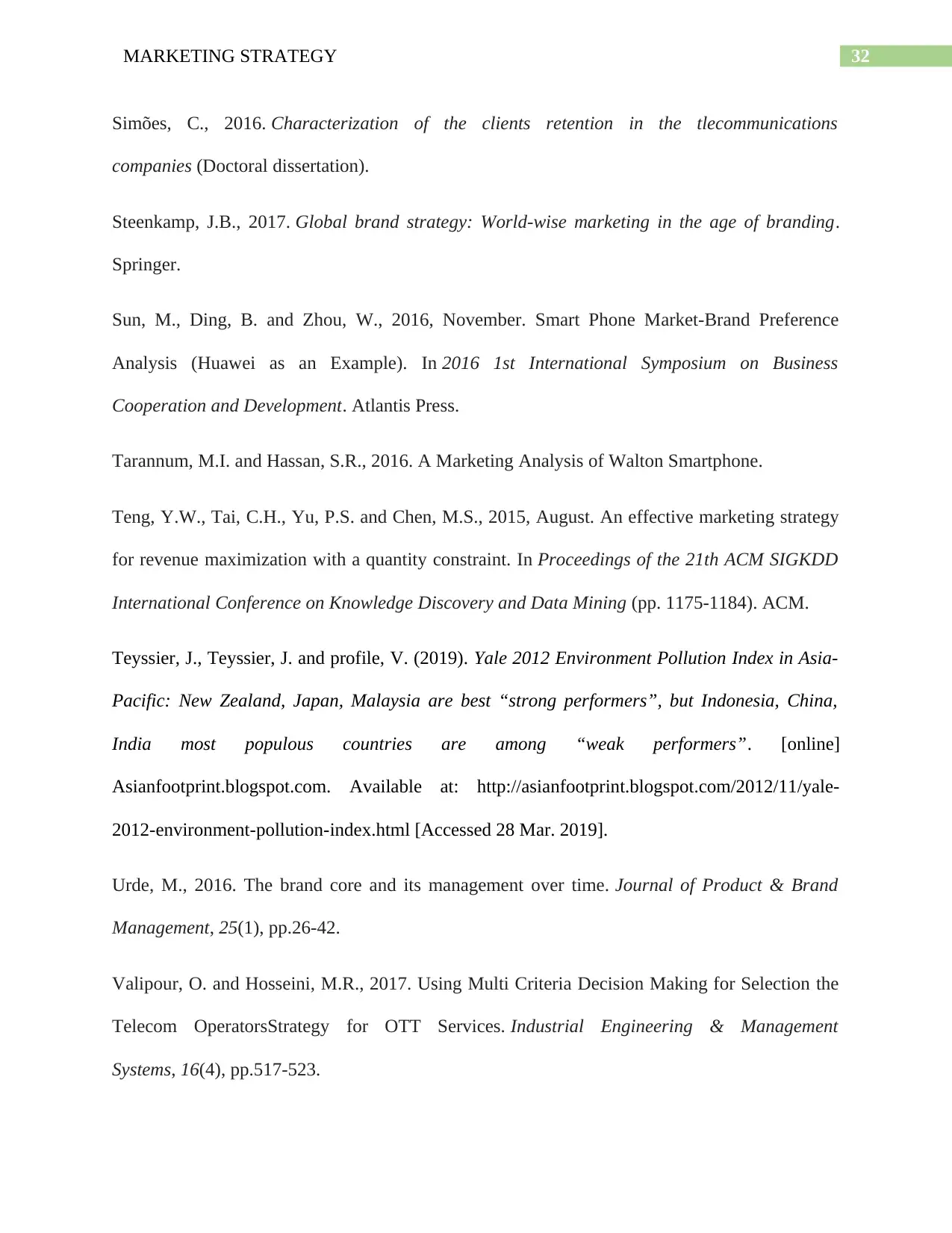
32MARKETING STRATEGY
Simões, C., 2016. Characterization of the clients retention in the tlecommunications
companies (Doctoral dissertation).
Steenkamp, J.B., 2017. Global brand strategy: World-wise marketing in the age of branding.
Springer.
Sun, M., Ding, B. and Zhou, W., 2016, November. Smart Phone Market-Brand Preference
Analysis (Huawei as an Example). In 2016 1st International Symposium on Business
Cooperation and Development. Atlantis Press.
Tarannum, M.I. and Hassan, S.R., 2016. A Marketing Analysis of Walton Smartphone.
Teng, Y.W., Tai, C.H., Yu, P.S. and Chen, M.S., 2015, August. An effective marketing strategy
for revenue maximization with a quantity constraint. In Proceedings of the 21th ACM SIGKDD
International Conference on Knowledge Discovery and Data Mining (pp. 1175-1184). ACM.
Teyssier, J., Teyssier, J. and profile, V. (2019). Yale 2012 Environment Pollution Index in Asia-
Pacific: New Zealand, Japan, Malaysia are best “strong performers”, but Indonesia, China,
India most populous countries are among “weak performers”. [online]
Asianfootprint.blogspot.com. Available at: http://asianfootprint.blogspot.com/2012/11/yale-
2012-environment-pollution-index.html [Accessed 28 Mar. 2019].
Urde, M., 2016. The brand core and its management over time. Journal of Product & Brand
Management, 25(1), pp.26-42.
Valipour, O. and Hosseini, M.R., 2017. Using Multi Criteria Decision Making for Selection the
Telecom OperatorsStrategy for OTT Services. Industrial Engineering & Management
Systems, 16(4), pp.517-523.
Simões, C., 2016. Characterization of the clients retention in the tlecommunications
companies (Doctoral dissertation).
Steenkamp, J.B., 2017. Global brand strategy: World-wise marketing in the age of branding.
Springer.
Sun, M., Ding, B. and Zhou, W., 2016, November. Smart Phone Market-Brand Preference
Analysis (Huawei as an Example). In 2016 1st International Symposium on Business
Cooperation and Development. Atlantis Press.
Tarannum, M.I. and Hassan, S.R., 2016. A Marketing Analysis of Walton Smartphone.
Teng, Y.W., Tai, C.H., Yu, P.S. and Chen, M.S., 2015, August. An effective marketing strategy
for revenue maximization with a quantity constraint. In Proceedings of the 21th ACM SIGKDD
International Conference on Knowledge Discovery and Data Mining (pp. 1175-1184). ACM.
Teyssier, J., Teyssier, J. and profile, V. (2019). Yale 2012 Environment Pollution Index in Asia-
Pacific: New Zealand, Japan, Malaysia are best “strong performers”, but Indonesia, China,
India most populous countries are among “weak performers”. [online]
Asianfootprint.blogspot.com. Available at: http://asianfootprint.blogspot.com/2012/11/yale-
2012-environment-pollution-index.html [Accessed 28 Mar. 2019].
Urde, M., 2016. The brand core and its management over time. Journal of Product & Brand
Management, 25(1), pp.26-42.
Valipour, O. and Hosseini, M.R., 2017. Using Multi Criteria Decision Making for Selection the
Telecom OperatorsStrategy for OTT Services. Industrial Engineering & Management
Systems, 16(4), pp.517-523.
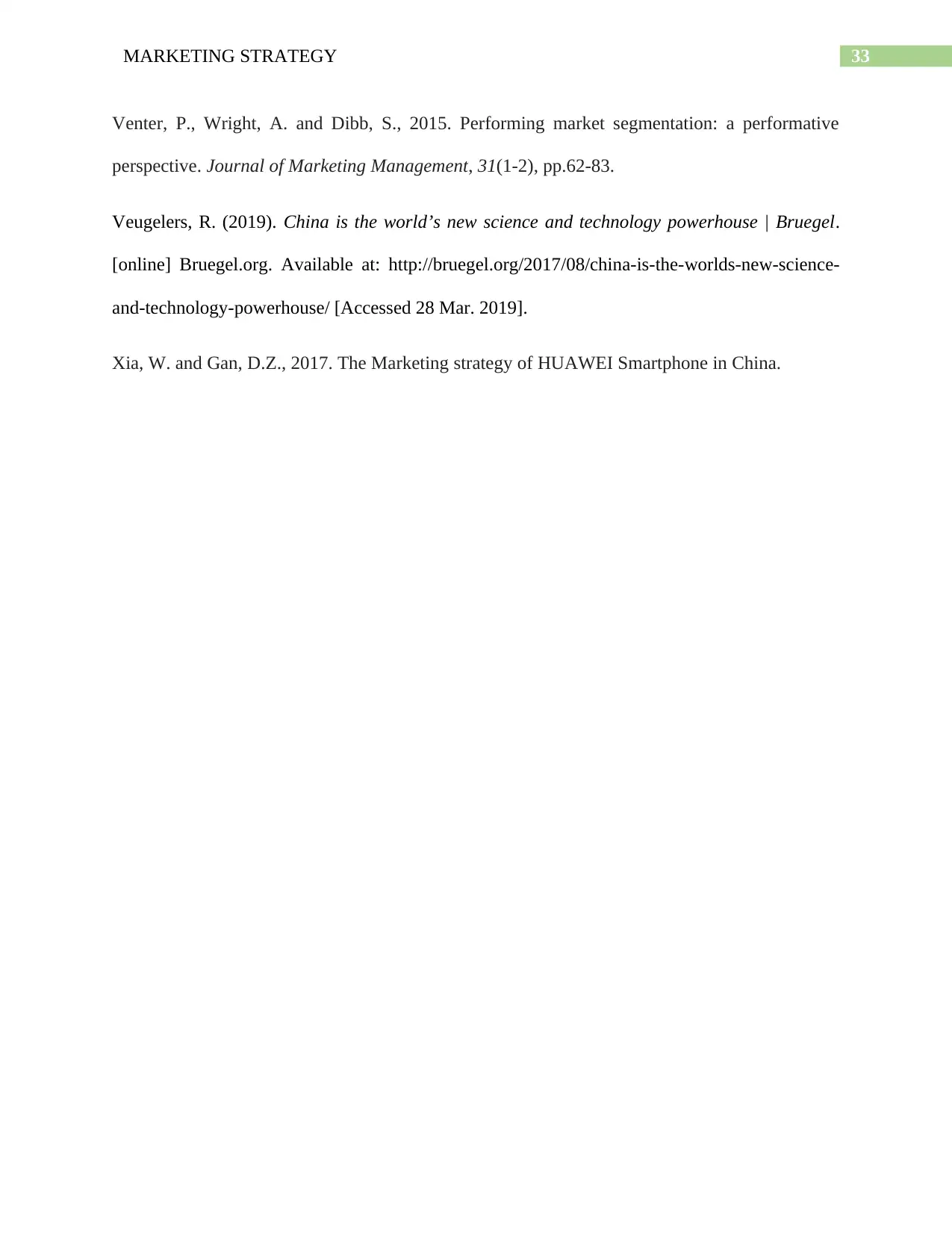
33MARKETING STRATEGY
Venter, P., Wright, A. and Dibb, S., 2015. Performing market segmentation: a performative
perspective. Journal of Marketing Management, 31(1-2), pp.62-83.
Veugelers, R. (2019). China is the world’s new science and technology powerhouse | Bruegel.
[online] Bruegel.org. Available at: http://bruegel.org/2017/08/china-is-the-worlds-new-science-
and-technology-powerhouse/ [Accessed 28 Mar. 2019].
Xia, W. and Gan, D.Z., 2017. The Marketing strategy of HUAWEI Smartphone in China.
Venter, P., Wright, A. and Dibb, S., 2015. Performing market segmentation: a performative
perspective. Journal of Marketing Management, 31(1-2), pp.62-83.
Veugelers, R. (2019). China is the world’s new science and technology powerhouse | Bruegel.
[online] Bruegel.org. Available at: http://bruegel.org/2017/08/china-is-the-worlds-new-science-
and-technology-powerhouse/ [Accessed 28 Mar. 2019].
Xia, W. and Gan, D.Z., 2017. The Marketing strategy of HUAWEI Smartphone in China.
1 out of 34
Related Documents
Your All-in-One AI-Powered Toolkit for Academic Success.
+13062052269
info@desklib.com
Available 24*7 on WhatsApp / Email
![[object Object]](/_next/static/media/star-bottom.7253800d.svg)
Unlock your academic potential
© 2024 | Zucol Services PVT LTD | All rights reserved.





